Chronological Order In Essay Writing
Table of contents
- 1 What Is a Chronological Order Essay
- 2 Chronological Order vs. Sequential Order
- 3 Importance of Correct Historical Occurrences
- 4 How to Write a Chronological Paragraph?
- 5.1 Pick an Idea and Make a Plan
- 5.2 Use a Variety of Sentence Structures to Keep Your Writing Interesting
- 5.3 Provide Sufficient Details
- 5.4 Use Transitional Words and Phrases, Such As “First,” “Next,” and “Then,” to Indicate the Chronological Flow
- 5.5 Use Headings and Subheadings to Organize Your Essay
- 5.6 Use Introductory and Concluding Sentences to Signal the Main Points of Each Paragraph
- 5.7 Use Appropriate Citations and References (Especially for the Historical Essay)
- 5.8 Maintain a Consistent Timeline and Avoid Jumping Back and Forth in Time
- 6 Conclusion
Writing a chronological essay is a pure pleasure. This type of university assignment is clear and structured, so knowing the basic requirements, you can easily cope with the task. Essays in chronological order require their author to have deep knowledge of the chosen subject. Not to stray from the course of the story, you need to be a real expert in this niche.
In this article, you will learn what a chronological-order essay is and how to write it. Also, you will find precious tips on making the writing process quick and enjoyable. So here are the milestones of our chronological essay guide:
- What a chronological order essay is;
- The difference between chronological and sequential order;
- Guidelines for chronological paragraph writing;
- Tips for writing an outstanding chronological essay.
Together we will consider each important point and dispel your doubts about the chronological essays. Without further ado, let’s get it started!

What Is a Chronological Order Essay
A chronological essay is an expository writing that describes historical events or a biography of a specific person. Surprisingly, not only students of the Faculty of History are faced with this type of essay. Whenever you have been given the task of writing about outstanding personalities, talking about your experiences, or presenting a life story or historical event, you will be faced with the need to use chronological order in writing.
This type of narrating writing essay requires you to present information in a logical and structured way. Expository essay writers must state all the events in the order in which they occurred. Moreover, you should dip the reader into the context of the event, explaining to him the background and the outcomes.
Chronological Order vs. Sequential Order
You may think that sequence and chronological order are identical concepts. Don’t worry, you’re not the only one who thinks so. These concepts are strongly related but not identical. Sequential order is based on the order of steps performed and how events occur relative to each other. But what is a chronological order of events?
The chronological timeline tells about the sequence of actions in time-space. Sequential order is well suited for writing step-by-step instructions and listing events. At the same time, the chronological order is excellent for narrating historical events and writing biographies.
Importance of Correct Historical Occurrences
Preliminary research is a solid foundation for your chronological essay. Take information only from reliable and trusted sources respected in science. Avoid unverified facts and loud statements. Make an effort to pre-study to avoid building an essay on false grounds. It may seem that a detailed study will take too much time, but on the contrary, it will save you the effort of rewriting the time order essay.
Check several sources for proof of the integrity of the information you found. Whenever you don’t have enough time for research, consider buying an essay rather than copying random facts from the web. After all, no matter how well you present the events in chronological order, if it does not correspond to reality, then your essay will lose all scientific value.
How to Write a Chronological Paragraph?
You can be assigned to write a chronological paragraph in your paper. This is also a type of chronological writing that you should do right if you need to get a good grade for your essay.
This paragraph should describe the sequence of events that occurred to a specific object or person. These events should be sorted chronologically, from the earliest to the latest. You should present the sequence and make logical transitions between events. This will help readers understand the connections between events and the outcomes of specific things.
You can write about anything interesting, there are almost no topics you should avoid in the essay if they meet the requirements. However, it is better when the subject is interesting to you.
When structuring these paragraphs, students not only present the facts but also explain them as causes and effects. If you don’t see connections between things, you should look closer and do more research.
To write a good chronological paragraph, you need to include crucial elements. Thus, it will be easier to structure the course of events. This guide may not only be used for chronological essays, it’s a rather versatile piece of advice on how to compose a personal statement . Among the integral components are:
- Topic sentence
- Important supporting points
- Chronological progression
- Coherence of the narrative
- Summarizing sentence
Topic sentences exist to briefly remind the reader of the main topic of your paper. Give enough detail to put the reader in the context of the chronological sequence essay. Do not jump in time, state all events clearly and unambiguously to maintain logical transitions. End your paragraph by summarizing what has been said so far.
Example of chronological order:
The Second World War was the largest bloody war, in which more than 30 countries participated and left an indelible mark on the history of mankind. (Strong topic sentence.) The prerequisites ( the supporting details ) for this historic event are considered Germany’s course for revenge in the First World War. Events began in September 1939 with the German attack on Poland. ( Chronological progression). The most important event of the Second World War is thought to be the Japanese attack on the United States of America in Pearl Harbor. After six years of fierce fighting, the Nazis were defeated by the Allies, and the war ended with the Japanese surrender on 2nd September 1945. ( Summarizing sentence)

Tips on Writing a Chronological Essay
You start the writing process by choosing a topic for it. Find an interesting topic that meets your assignment’s requirements, or ask your teacher to give you a topic.
If you are stuck with creating this paper, you can use an essay editing service to prepare it. Its writers have experience working on chronological essays, they can help you with narrative and cause-and-effect paper .
Then you should research and find as much information on your topic as possible. Collect this information in a well-organized format so you can reference any of it if needed, and don’t forget to keep the dates of all events.
Pick an Idea and Make a Plan
If you need to create informative essays about a specific historical event, you should start from the beginning of this event or even with earlier events that lead to it. If a particular group organizes an event, tell the motives of this group, how they got to this idea, and how they started working on it. Then write about each step from the beginning to the conclusion of this event and arrange the events in chronological order.
Use a Variety of Sentence Structures to Keep Your Writing Interesting
If you only use simple sentences or start each sentence with the word «then», your writing will be boring to read. PapersOwl specialists advise studying several chronological ordering examples to understand the linking words and the structuring strategy. Use different stylistic devices as well as different types of complex sentences.
Provide Sufficient Details
Provide your reader with the full context of the story in time-order paragraphs. To understand the course of action of the chronological essay, the reader must be aware of the background and cause of historical events. At the same time, try not to overload your compositions with unnecessary details.
Use Transitional Words and Phrases, Such As “First,” “Next,” and “Then,” to Indicate the Chronological Flow
Sequencers help keep the story logical, they’re keywords for chronological order that make the essay flow smoothly. Use transitional words to direct the reader through the flow of your story. Don’t forget to use different expressions to avoid tautology.
Use Headings and Subheadings to Organize Your Essay
Provide clear divisions so that the paper becomes much more readable. Large arrays of text always repel the reader, so use a proper chronological structure. Also, headings and subheadings will help you further structure your essay.
Use Introductory and Concluding Sentences to Signal the Main Points of Each Paragraph
A thesis statement that summarizes the main message of your chronological essays should be restructured and repeated several times during writing. This technique is used by writers to express the main idea of the essay in the introduction and throughout the text. The thesis proposal should be catchy and memorable.
Use Appropriate Citations and References (Especially for the Historical Essay)
There could be many sources of false information on the Internet. Students should check information and put only proven citations into the chronological expositions. We know it could be challenging to deal with citation norms, so we’re always ready to write your paper for you . Be sure to check the accuracy of the quotes and the veracity of the facts you refer to.
Maintain a Consistent Timeline and Avoid Jumping Back and Forth in Time
When you have the list of essential timeline events, you can arrange the events in the order in which they happened. It helps you to use the correct order in an essay from the earliest events in your story to the latest. You can use simple editors or a spreadsheet for sorting lists.
When you write a chronological essay, nothing may cause you problems if you are well-oriented to the chosen subject. You should carefully choose topics for writing, do not forget about the preliminary study, and double-check the sources you use.
After reading our guide in detail, you will undoubtedly be able to write a decent chronological essay. However, even if you find it difficult to find inspiration for writing, this is not a problem either, as you can resort to exposition editing services. Remember that an experienced team of professionals is always ready to help you with heavy research writing essays.
Readers also enjoyed

WHY WAIT? PLACE AN ORDER RIGHT NOW!
Just fill out the form, press the button, and have no worries!
We use cookies to give you the best experience possible. By continuing we’ll assume you board with our cookie policy.

How to plan an essay: Essay Planning
- What's in this guide
- Essay Planning
- Additional resources
How to plan an essay
Essay planning is an important step in academic essay writing.
Proper planning helps you write your essay faster, and focus more on the exact question. As you draft and write your essay, record any changes on the plan as well as in the essay itself, so they develop side by side.
One way to start planning an essay is with a ‘box plan’.
First, decide how many stages you want in your argument – how many important points do you want to make? Then, divide a box into an introduction + one paragraph for each stage + a conclusion.
Next, figure out how many words per paragraph you'll need.
Usually, the introduction and conclusion are each about 10% of the word count. This leaves about 80% of the word count for the body - for your real argument. Find how many words that is, and divide it by the number of body paragraphs you want. That tells you about how many words each paragraph can have.
Remember, each body paragraph discusses one main point, so make sure each paragraph's long enough to discuss the point properly (flexible, but usually at least 150 words).
For example, say the assignment is
Fill in the table as follows:
Next, record each paragraph's main argument, as either a heading or topic sentence (a sentence to start that paragraph, to immediately make its point clear).
Finally, use dot points to list useful information or ideas from your research notes for each paragraph. Remember to include references so you can connect each point to your reading.
The other useful document for essay planning is the marking rubric .
This indicates what the lecturer is looking for, and helps you make sure all the necessary elements are there.
Pathways and Academic Learning Support

- << Previous: What's in this guide
- Next: Additional resources >>
- Last Updated: Feb 15, 2024 1:23 PM
- URL: https://libguides.newcastle.edu.au/essay_planning

Want to create or adapt books like this? Learn more about how Pressbooks supports open publishing practices.
9.3 Organizing Your Writing
Learning objectives.
- Understand how and why organizational techniques help writers and readers stay focused.
- Assess how and when to use chronological order to organize an essay.
- Recognize how and when to use order of importance to organize an essay.
- Determine how and when to use spatial order to organize an essay.
The method of organization you choose for your essay is just as important as its content. Without a clear organizational pattern, your reader could become confused and lose interest. The way you structure your essay helps your readers draw connections between the body and the thesis, and the structure also keeps you focused as you plan and write the essay. Choosing your organizational pattern before you outline ensures that each body paragraph works to support and develop your thesis.
This section covers three ways to organize body paragraphs:
- Chronological order
- Order of importance
- Spatial order
When you begin to draft your essay, your ideas may seem to flow from your mind in a seemingly random manner. Your readers, who bring to the table different backgrounds, viewpoints, and ideas, need you to clearly organize these ideas in order to help process and accept them.
A solid organizational pattern gives your ideas a path that you can follow as you develop your draft. Knowing how you will organize your paragraphs allows you to better express and analyze your thoughts. Planning the structure of your essay before you choose supporting evidence helps you conduct more effective and targeted research.
Chronological Order
In Chapter 8 “The Writing Process: How Do I Begin?” , you learned that chronological arrangement has the following purposes:
- To explain the history of an event or a topic
- To tell a story or relate an experience
- To explain how to do or to make something
- To explain the steps in a process
Chronological order is mostly used in expository writing , which is a form of writing that narrates, describes, informs, or explains a process. When using chronological order, arrange the events in the order that they actually happened, or will happen if you are giving instructions. This method requires you to use words such as first , second , then , after that , later , and finally . These transition words guide you and your reader through the paper as you expand your thesis.
For example, if you are writing an essay about the history of the airline industry, you would begin with its conception and detail the essential timeline events up until present day. You would follow the chain of events using words such as first , then , next , and so on.
Writing at Work
At some point in your career you may have to file a complaint with your human resources department. Using chronological order is a useful tool in describing the events that led up to your filing the grievance. You would logically lay out the events in the order that they occurred using the key transition words. The more logical your complaint, the more likely you will be well received and helped.
Choose an accomplishment you have achieved in your life. The important moment could be in sports, schooling, or extracurricular activities. On your own sheet of paper, list the steps you took to reach your goal. Try to be as specific as possible with the steps you took. Pay attention to using transition words to focus your writing.
Keep in mind that chronological order is most appropriate for the following purposes:
- Writing essays containing heavy research
- Writing essays with the aim of listing, explaining, or narrating
- Writing essays that analyze literary works such as poems, plays, or books
When using chronological order, your introduction should indicate the information you will cover and in what order, and the introduction should also establish the relevance of the information. Your body paragraphs should then provide clear divisions or steps in chronology. You can divide your paragraphs by time (such as decades, wars, or other historical events) or by the same structure of the work you are examining (such as a line-by-line explication of a poem).
On a separate sheet of paper, write a paragraph that describes a process you are familiar with and can do well. Assume that your reader is unfamiliar with the procedure. Remember to use the chronological key words, such as first , second , then , and finally .
Order of Importance
Recall from Chapter 8 “The Writing Process: How Do I Begin?” that order of importance is best used for the following purposes:
- Persuading and convincing
- Ranking items by their importance, benefit, or significance
- Illustrating a situation, problem, or solution
Most essays move from the least to the most important point, and the paragraphs are arranged in an effort to build the essay’s strength. Sometimes, however, it is necessary to begin with your most important supporting point, such as in an essay that contains a thesis that is highly debatable. When writing a persuasive essay, it is best to begin with the most important point because it immediately captivates your readers and compels them to continue reading.
For example, if you were supporting your thesis that homework is detrimental to the education of high school students, you would want to present your most convincing argument first, and then move on to the less important points for your case.
Some key transitional words you should use with this method of organization are most importantly , almost as importantly , just as importantly , and finally .
During your career, you may be required to work on a team that devises a strategy for a specific goal of your company, such as increasing profits. When planning your strategy you should organize your steps in order of importance. This demonstrates the ability to prioritize and plan. Using the order of importance technique also shows that you can create a resolution with logical steps for accomplishing a common goal.
On a separate sheet of paper, write a paragraph that discusses a passion of yours. Your passion could be music, a particular sport, filmmaking, and so on. Your paragraph should be built upon the reasons why you feel so strongly. Briefly discuss your reasons in the order of least to greatest importance.
Spatial Order
As stated in Chapter 8 “The Writing Process: How Do I Begin?” , spatial order is best used for the following purposes:
- Helping readers visualize something as you want them to see it
- Evoking a scene using the senses (sight, touch, taste, smell, and sound)
- Writing a descriptive essay
Spatial order means that you explain or describe objects as they are arranged around you in your space, for example in a bedroom. As the writer, you create a picture for your reader, and their perspective is the viewpoint from which you describe what is around you.
The view must move in an orderly, logical progression, giving the reader clear directional signals to follow from place to place. The key to using this method is to choose a specific starting point and then guide the reader to follow your eye as it moves in an orderly trajectory from your starting point.
Pay attention to the following student’s description of her bedroom and how she guides the reader through the viewing process, foot by foot.
Attached to my bedroom wall is a small wooden rack dangling with red and turquoise necklaces that shimmer as you enter. Just to the right of the rack is my window, framed by billowy white curtains. The peace of such an image is a stark contrast to my desk, which sits to the right of the window, layered in textbooks, crumpled papers, coffee cups, and an overflowing ashtray. Turning my head to the right, I see a set of two bare windows that frame the trees outside the glass like a 3D painting. Below the windows is an oak chest from which blankets and scarves are protruding. Against the wall opposite the billowy curtains is an antique dresser, on top of which sits a jewelry box and a few picture frames. A tall mirror attached to the dresser takes up most of the wall, which is the color of lavender.
The paragraph incorporates two objectives you have learned in this chapter: using an implied topic sentence and applying spatial order. Often in a descriptive essay, the two work together.
The following are possible transition words to include when using spatial order:
- Just to the left or just to the right
- On the left or on the right
- Across from
- A little further down
- To the south, to the east, and so on
- A few yards away
- Turning left or turning right
On a separate sheet of paper, write a paragraph using spatial order that describes your commute to work, school, or another location you visit often.
Collaboration
Please share with a classmate and compare your answers.
Key Takeaways
- The way you organize your body paragraphs ensures you and your readers stay focused on and draw connections to, your thesis statement.
- A strong organizational pattern allows you to articulate, analyze, and clarify your thoughts.
- Planning the organizational structure for your essay before you begin to search for supporting evidence helps you conduct more effective and directed research.
- Chronological order is most commonly used in expository writing. It is useful for explaining the history of your subject, for telling a story, or for explaining a process.
- Order of importance is most appropriate in a persuasion paper as well as for essays in which you rank things, people, or events by their significance.
- Spatial order describes things as they are arranged in space and is best for helping readers visualize something as you want them to see it; it creates a dominant impression.
Writing for Success Copyright © 2015 by University of Minnesota is licensed under a Creative Commons Attribution-NonCommercial-ShareAlike 4.0 International License , except where otherwise noted.

Preparing for Academic Writing
- Understanding the Question
- Planning Your Assignment Timeline
- Outlining Your Essay
- Video Playlist
- Audio Playlist
- Downloadable Resources
- Further Reading
- Relevant Workshops This link opens in a new window
- Introduction
- Guiding Principles for an Assignment Timeline
- Backwards Planning
After you have gained an understanding of your assignment by analysing the information given to you, it is advised that you create an assignment timeline. Creating an assignment timeline can help increase your certainty and clarity over what you need to do and when.
Use the tabs to learn more about how you can plan your assignment timeline.
You may feel that it is difficult to create a timeline this early into your assignment, or that it is hard to accurately predict exactly how long each step will take. These feelings should be considered when making a plan. First you should note that your initial attempt to plan is educated guesswork. You are simply considering what steps you think you need to take and how long they should be. As you progress through your assignment timeline you can review your plan and update the timeline to be more accurate.
Inevitably some things may take shorter or longer than you had initially planned. If you are progressing quickly that is good news as you have some extra time that could be spent on your assignment or on something else of your choosing. However, do make sure that you are confident that you have met the required marking criteria within the step if you are moving quicker than planned. If things are taking longer than planned, consider how you will adjust your timings and steps to ensure that your work can be handed in on time. If this is not possible consider if you could apply for extra time through the Late Submission Request Procedure or the Exceptional Extenuating Circumstances Procedure .
When creating your initial plan, it may be wise to plan some leeway into your schedule. A good rule of thumb would be to plan extra time in each step. So if you expect research would take you two weeks, plan three weeks to complete it in. If it takes the normal amount of time, you have an extra week. If it takes longer then you are prepared. Another method of creating leeway is to aim to beat your deadline by submitting one week in advance.
During your studies you will often be working towards multiple assignments at once, alongside other deadlines (such as applications) and any responsibilities (work, caring, childcare etc.). When planning your assignment you should take into account that your assignment may not be your only focus. For more information on completing multiple assignments see our academic writing is assessment season livestream .
You may find it easier to plan your assignment by starting from your deadline (or your personal deadline if you are aiming to submit in advance), and working backwards to the start of your assignment. If you attribute estimated times to each step you can establish when you realistically need to start. Backwards planning allows you to consider the whole process, so that you allow crucial time for referencing and proofreading. Proofreading, for example, is an opportunity to evaluate if you have hit the marking criteria, and then to make any necessary actions (such as further reading or rewriting a paragraph). If this step is undervalued in planning then you may find flaws in your work but not have the time to fix them.
If you would like to know more about how to time manage or how to motivate yourself throughout your academic writing timeline, see our Improving Marks in Academic Writing Guide.
In this episode of the Assignment Journey Podcast Alex and Diana (Skills Graduate Placement), discuss how you can use your understanding of the assignment to structure your assignment. They go through what is expected in an introduction, main body and conclusion of an essay as well as a simple paragraph structure.
Managing time over the course
In this video from the Time Management workshop, Naomi from the Skills Team discusses how you can manage your time over the course of a semester through backwards planning.
Academic writing in assessment
In this hour long livestream, Alexander and Naomi discuss their advice for thriving in assessment season, including how you can time manage during this tricky period and how to manage multiple assessments at once whilst looking out for your mental health.
Structure and Planning
- << Previous: Understanding the Question
- Next: Outlining Your Essay >>
- Last Updated: Feb 5, 2024 11:40 AM
- URL: https://libguides.derby.ac.uk/preparing-for-academic-writing
How to Develop a Research Paper Timeline
- Writing Research Papers
- Writing Essays
- English Grammar
- M.Ed., Education Administration, University of Georgia
- B.A., History, Armstrong State University
Research papers come in many sizes and levels of complexity. There is no single set of rules that fits every project, but there are guidelines you should follow to keep yourself on track throughout the weeks as you prepare, research, and write. You will complete your project in stages, so you must plan ahead and give yourself enough time to complete every stage of your work.
Your first step is to write down the due date for your paper on a big wall calendar , in your planner , and in an electronic calendar.
Plan backward from that due date to determine when you should have your library work completed. A good rule of thumb is to spend:
- Fifty percent of your time researching and reading
- Ten percent of your time sorting and marking your research
- Forty percent of your time writing and formatting
Timeline for Researching and Reading Stage
- 1 week for short papers with one or two sources
- 2-3 weeks for papers up to ten pages
- 2-3 months for a thesis
It’s important to get started right away on the first stage. In a perfect world, we would find all of the sources we need to write our paper in our nearby library. In the real world, however, we conduct internet queries and discover a few perfect books and articles that are absolutely essential to our topic—only to find that they are not available at the local library.
The good news is that you can still get the resources through an interlibrary loan. But that will take time. This is one good reason to do a thorough search early on with the help of a reference librarian .
Give yourself time to collect many possible resources for your project. You will soon find that some of the books and articles you choose don’t actually offer any useful information for your particular topic. You’ll need to make a few trips to the library. You won’t finish in one trip.
You’ll also discover that you will find additional potential sources in the bibliographies of your first selections. Sometimes the most time-consuming task is eliminating potential sources.
Timeline for Sorting and Marking Your Research
- 1 day for a short paper
- 3-5 days for papers up to ten pages
- 2-3 weeks for a thesis
You should read each of your sources at least twice. Read your sources the first time to soak in some information and to make notes on research cards.
Read your sources a second time more quickly, skimming through the chapters and putting sticky note flags on pages that contain important points or pages that contain passages that you want to cite. Write keywords on the sticky note flags.
Timeline for Writing and Formatting
- Four days for a short paper with one or two sources
- 1-2 weeks for papers up to ten pages
- 1-3 months for a thesis
You don’t really expect to write a good paper on your first attempt, do you?
You can expect to pre-write, write, and rewrite several drafts of your paper. You’ll also have to rewrite your thesis statement a few times, as your paper takes shape.
Don’t get held up writing any section of your paper—especially the introductory paragraph. It is perfectly normal for writers to go back and complete the introduction once the rest of the paper is completed.
The first few drafts don’t have to have perfect citations. Once you begin to sharpen your work and you’re heading toward a final draft, you should tighten your citations. Use a sample essay if you need to, just to get the formatting down.
Make sure your bibliography contains every source you’ve used in your research.
- What Is a Research Paper?
- How to Write a 10-Page Research Paper
- What Is a Senior Thesis?
- How to Organize Research Notes
- Research Note Cards
- How to Write a Research Paper That Earns an A
- College School Supplies List
- Organize Your Time With a Day Planner
- An Introduction to Academic Writing
- Writing a Paper about an Environmental Issue
- Documentation in Reports and Research Papers
- Finding Trustworthy Sources
- Definition of Appendix in a Book or Written Work
- What Is a Bibliography?
- 10 Places to Research Your Paper
- MLA Sample Pages
What are your chances of acceptance?
Calculate for all schools, your chance of acceptance.
Your chancing factors
Extracurriculars.
A Guide to College Application Essay Timelines
This article was written based on the information and opinions presented by Robert Crystal and Christopher Kilner in a CollegeVine livestream. You can watch the full livestream for more info.
What’s Covered
Make a plan.
- September and October
November and December
Anyone can write an excellent essay if they have enough time, and it’s important to prioritize writing a strong essay because it plays such an outsized role in the application process. With sufficient time and preparation, you can also decrease your word count and produce a piece of writing that is brief and high quality. “If I had more time, I would have written a shorter letter,” is a phrase often attributed to many famous scholars and statespeople. The best thing that you can do to set yourself up for success is to plan ahead, giving yourself plenty of time to engage in the writing process and produce multiple drafts of your essay.
It is most helpful to use the summer before your senior year of high school—or the year during which you are applying—to prepare your college application essays, with the goal of completing at least your personal statement by early September. The following timeline roughly outlines the steps of the writing process that you should take each month to achieve this goal.
For more guidance on writing your personal statement, read our article on how to write the Common Application essays for 2022-2023 .
Review the Common Application essay prompts for the most recent application season. These prompts often remain the same as the previous year. Pick a few essay prompts that resonate with you, and start to contemplate them as you go through your day. Maybe you can use your daily bus ride or afternoon stroll to brainstorm possible topics for the prompts that interest you. It is always helpful to have a journal, a note-taking app on your phone, or scratch paper on hand where you can record your ideas.
In addition to journaling about potential material for your essays, it’s helpful to practice thinking about and articulating your responses to various questions about who you are and how you think and view the world. Here are a few examples:
- What are your core values? How did you develop this system of values?
- What motivates you? How do you motivate yourself?
- What are you passionate about? If you could study anything, what would you want to learn more about?
- What issues in your local community or at the city, state, national, or global level are most concerning to you?
- What are your short-term goals and long-term dreams and aspirations? Where would you like to see yourself in five or 10 years? What are lifetime goals that you have?
For more brainstorming questions, read “ 7 Questions to Help You Start Writing Your College Essays .”
Your goal for May is to outline and write a complete rough draft of your personal statement. The hardest part of writing your essay is committing something to paper, and the best draft is often a bad first draft. Everything becomes easier once you have words to edit. Your first draft does not need to be amazing or even passable; it can be completely awful, and it will still be better than a blank page.
Use June to edit the rough draft that you produced in May. This is where you will dive into the process of constructing your narrative. Then, you should aim to produce at least three or more additional drafts. These will likely be the most time-intensive drafts that you produce.
At this point in the process, you should work on developing your ideas mostly on your own. You do not need to share your essay with anyone else unless you feel confident that your draft is ready for others to review or that you cannot progress without outside input.
You should continue producing new drafts of your personal statement. This means you should read aloud your essay from beginning to end and make changes to word choice, grammar, sentence structure, paragraph structure, and content. You should do this every three or so days.
Now is a great time to share your drafts with a close family member, friend, teacher, or high school counselor. In addition to showing your essays to members of your inner circle, you should prioritize finding a neutral third party to review your essays and provide critical feedback. This third party should be someone familiar with the college admissions process, such as a current college student, a recent college graduate, or a college consultant, like a CollegeVine Advisor .
Ask each person who reads your essay to provide written feedback, or have a conversation with them about their impressions, suggestions, and questions. Of course, too many cooks can spoil the broth, as the saying goes. Show your essay to enough people to get a broad range of opinions but not so many that you feel overwhelmed or confused.
This month should be devoted to incorporating feedback from people who have read your essay and doing the final polishing work that will take your essay to the next level. By the end of August, you should have a final draft of your personal statement that you would feel confident submitting.
September and October
Work on and complete your supplemental essays in preparation for meeting the early action and early decision deadlines.
Work on and complete your supplemental essays in preparation for meeting the regular decision deadline.
Related CollegeVine Blog Posts

- PRO Courses Guides New Tech Help Pro Expert Videos About wikiHow Pro Upgrade Sign In
- EDIT Edit this Article
- EXPLORE Tech Help Pro About Us Random Article Quizzes Request a New Article Community Dashboard This Or That Game Popular Categories Arts and Entertainment Artwork Books Movies Computers and Electronics Computers Phone Skills Technology Hacks Health Men's Health Mental Health Women's Health Relationships Dating Love Relationship Issues Hobbies and Crafts Crafts Drawing Games Education & Communication Communication Skills Personal Development Studying Personal Care and Style Fashion Hair Care Personal Hygiene Youth Personal Care School Stuff Dating All Categories Arts and Entertainment Finance and Business Home and Garden Relationship Quizzes Cars & Other Vehicles Food and Entertaining Personal Care and Style Sports and Fitness Computers and Electronics Health Pets and Animals Travel Education & Communication Hobbies and Crafts Philosophy and Religion Work World Family Life Holidays and Traditions Relationships Youth
- Browse Articles
- Learn Something New
- Quizzes Hot
- This Or That Game
- Train Your Brain
- Explore More
- Support wikiHow
- About wikiHow
- Log in / Sign up
- Education and Communications
How to Make a Timeline
Last Updated: March 21, 2024 Fact Checked
This article was co-authored by Emily Listmann, MA and by wikiHow staff writer, Danielle Blinka, MA, MPA . Emily Listmann is a Private Tutor and Life Coach in Santa Cruz, California. In 2018, she founded Mindful & Well, a natural healing and wellness coaching service. She has worked as a Social Studies Teacher, Curriculum Coordinator, and an SAT Prep Teacher. She received her MA in Education from the Stanford Graduate School of Education in 2014. Emily also received her Wellness Coach Certificate from Cornell University and completed the Mindfulness Training by Mindful Schools. This article has been fact-checked, ensuring the accuracy of any cited facts and confirming the authority of its sources. This article has been viewed 869,933 times.
A timeline provides a visual representation of events that helps you better understand history, a story, a process or any other form of an event sequence. You can make a timeline to fit a variety of subjects, so they’re a common academic project. Fortunately, they are also really easy to make. To make a timeline, research your topic, create your project, and organize the events chronologically.
Researching Your Topic

- Conduct Internet research, check out books from the library, or visit a museum or a historical site that relates in some way to your topic.
- Try to use multiple websites, books, articles, and maybe even a documentary. Aim to have at least 3 different sources.

- Personal details such as births, deaths, and other important dates should be added
- Historical events that impacted the topic of the timeline should also be incorporated into your timeline
- Important events that shaped the topic should be included as well

Creating a Framework

- Use a ruler if you are making your timeline by hand.
- If you are creating a digital timeline, choose a template.

- You don’t have to start with someone’s birth or end with the person’s death. A timeline is just a series of related events, not necessarily a biography.
- Consider your topic and narrow it to select the right starting point and ending point.

- If you’re doing this by hand, write out all the events on a separate sheet of paper before adding them to the timeline so you can figure out how much space each entry will take.
- Alternatively, you could type up each event, then print it, cut it out, and paste it to the timeline.
- If you’re using a digital method, create a slide for each event.
- Include drawings or images to add visual interest to the timeline.

- These time increments are not the years of your events. They are evenly spaced increments, such as 5 years, 10 years, or 20 years. For example, you might mark 1920, 1930, 1940, and 1950, even though your events take place in 1923, 1928, 1938, and 1943.

- Organize the dates sequentially. The events need to be on the timeline in chronological order, not in order of importance or interest. For example, events listed throughout a year should start in January and end in December. [9] X Research source
Filling in Your Timeline

- The Life and Times of Nelson Mandela
- Beverly Hills, 90210: A Recent History
- JD Salinger's Storied Career
- California's Ancient Redwoods
- A Day in the Life of a Praying Mantis

- If you’re creating a digital timeline, type up your entries.

Sample Timeline

Community Q&A
- If you need to, alternate the place you are writing the events. Write one event above the line, then the next one below it. Thanks Helpful 0 Not Helpful 0
- Try to write small. Thanks Helpful 0 Not Helpful 0
- Be sure to cite your sources properly. Thanks Helpful 0 Not Helpful 0

You Might Also Like

- ↑ https://www.thehomeschoolmom.com/how-to-make-a-timeline-easily/
- ↑ https://timeline.knightlab.com/
- ↑ https://creately.com/blog/creately/how-to-draw-a-timeline/
- ↑ https://www.youtube.com/watch?v=pz9o15QKzMM
- ↑ http://www.datesandevents.org/creating-a-timeline.htm
- ↑ http://www.readingrockets.org/article/creating-timelines
About This Article

If you need to make a timeline to help you better understand a story or a historical occurrence, make a list of all of the events you want to include in the timeline. Aim for no more than 20 events in a timeline, and look for relevant details that add interest to the story you are telling. Sketch out a line using a pencil, and label the timeline with the project title and boundary years. Add the most important dates to the timeline in sequential order, then fill in any details. For tips from our reviewer on different ways to structure your timeline, read on! Did this summary help you? Yes No
- Send fan mail to authors
Reader Success Stories
Andria Metcalf
Apr 7, 2018
Did this article help you?

Apr 15, 2018
Lorelei Rye
Oct 19, 2017
Nov 28, 2023
Jordyn Lenton
Feb 17, 2017

Featured Articles

Trending Articles

Watch Articles

- Terms of Use
- Privacy Policy
- Do Not Sell or Share My Info
- Not Selling Info
Don’t miss out! Sign up for
wikiHow’s newsletter
What is A Timeline - Explain with Examples
A timeline is an essential tool to illustrate the chronology of events or activities. We use timelines for research, studies and event planning. Timelines make it easier for students to understand the historical events related to any subject in an orderly manner. It helps researchers keep track of the time interval between various experiments and discoveries. You can learn anything you want to know about timelines from here. Don't forget to check out the examples down here to understand the types and uses of a timeline.
What is a Timeline?
Timeline is the alignment of time, a chronological statement, to define a certain chain of events or activities that happened at a particular phase. In a visual context, it is a representation of the data, defined through lists, tables or graphics, where its all jotted down, sequenced in the same chronological order.
Like a flowchart, it helps users identify specific patterns in a scheme or course of procedure with a streamlined format, concisely depicting different temporal relations. It is simple to look at, handy to work with and easier to manage and remember. You can also find more timeline examples here.

Purposes of Using a Timeline
Time is a pivotal record. But it is also hard to keep track of when multiple things are happening simultaneously and in the long run. So the purpose of a Timeline is to put it all in order with a figurative visualization of the process, highlighting key elements without much elaboration.
Scholars and teachers widely use this sort of content, for knowledge sharing, since these are much more interactive and attractive than textbook content. As for enterprises, they mainly use such data to track the progress of a project or plan based on it. Let us explore the variations of timelines.
Different Types of Timelines
There are various types of timelines that you can use for many things. You can plan your wedding ceremony or describe some specific event at the given point in time. You can also use it to understand someone's history or create a new marketing plan. Each timeline follows a different format, and if you want to create a timeline, you have to check out its various examples down here and find a suitable design.
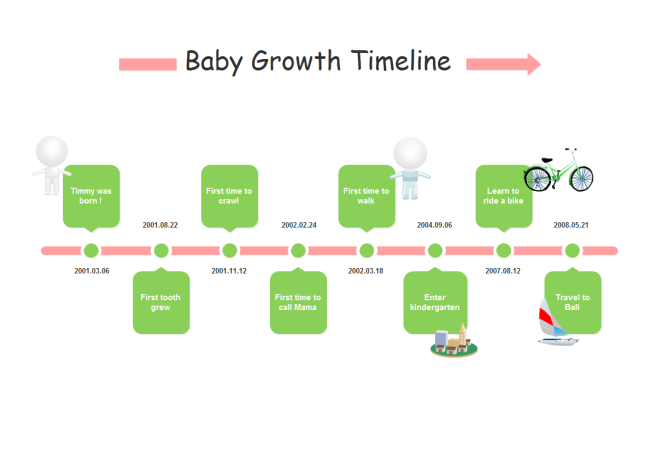
The chronology timeline is considered as the most common-seen timeline. It visualizes events in chronological order. Normally, the timeline starts with the earliest date and ends up with the latest date arranged on the X-axis from left to right. You can easily find chronology timelines in history books and it is very effective to use this type of diagram to tell a historical event.

Gantt Charts are used for managing projects, putting all aligning factors like project schedule, progress report, workflow, and client into a singular spreadsheet-like template. This document is meant to be shared with all team members, making the plans and goals clear for everyone. These charts can be complex-looking, given the factors it covers and how big the project is. They are usually created on horizontal bar charts with some kind of progress indicator, together with the latest update at the bottom of the page.

Source: www.bbvaopenmind.com
The two types of times that are introduced above belong to a static timeline. On the contrary, the interactive timeline is a dynamic timeline, which you can feel free to scroll, zoom in, zoom out or change the data in real-time. If you have large amounts of data or this event lasts for a long period, a scrollable, interactive timeline will be your best choice.

A horizontal timeline or a line plot visually represents the events that occurred horizontally in the given date and time. A line moving from left to right represents the time period. We use pointers to add text to relate the given activity to a specific point in time. This timeline is best for presentations as it makes your report eye-catching. It is sometimes hard to understand a horizontal timeline as you can't add much text due to a lack of available space.
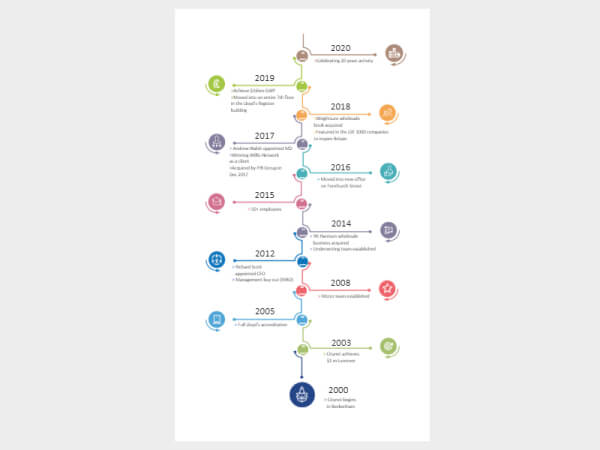
A vertical timeline is the most used timeline for reports and research. Using this one is your best option when you have lots of text to add to the timeline. A straight vertical line represents the given time period. You can label the timeline by adding text on both left and right sides. You can even write long sentences to explain your research better. It makes everything easy to understand if you are working with a complicated timeline.
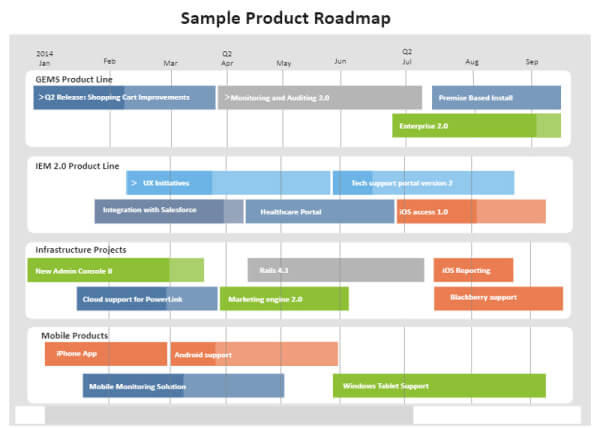
A roadmap timeline is beneficial in project management. It divides the timeline into various sections to represent the project's tasks in an orderly manner based on when the team will start working and which job takes priority. It gives the general idea of time spent on completing each task to finalize the project in time. The reader can easily understand it and work accordingly to do the project quickly.

A biographical timeline is the best tool to illustrate the history of a person and represent various events based on the given time period. We use this timeline to improve our understanding of a person. Students can quickly learn the history of someone and the critical events in that person's life with the biographical timeline. Human resources also use it to find the right person for the job. These timelines help a lot if you are preparing someone’s biography.
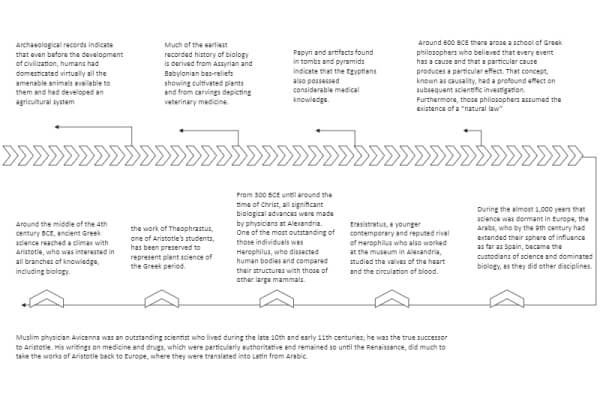
The biological timeline describes the important events related to the science subject in history from 1600 to the current year. It is mainly used in the study field where students can learn about the biological history of the earth and all science-related events efficiently and creatively. It is hard to create a biological timeline covering the entire history for several hundred years. That is why most of these timelines only contain a specific time interval or classification of events based on the subject.

A company background timeline is a helpful chart that illustrates the eventful history of a company or a business in a creative way. Making a timeline gets complicated and sometimes dull, but with a company background timeline, you can use creative ways to represent the company's history. It is also used for the start-up of any business when it is essential to complete each task in the given time and plan the next step.
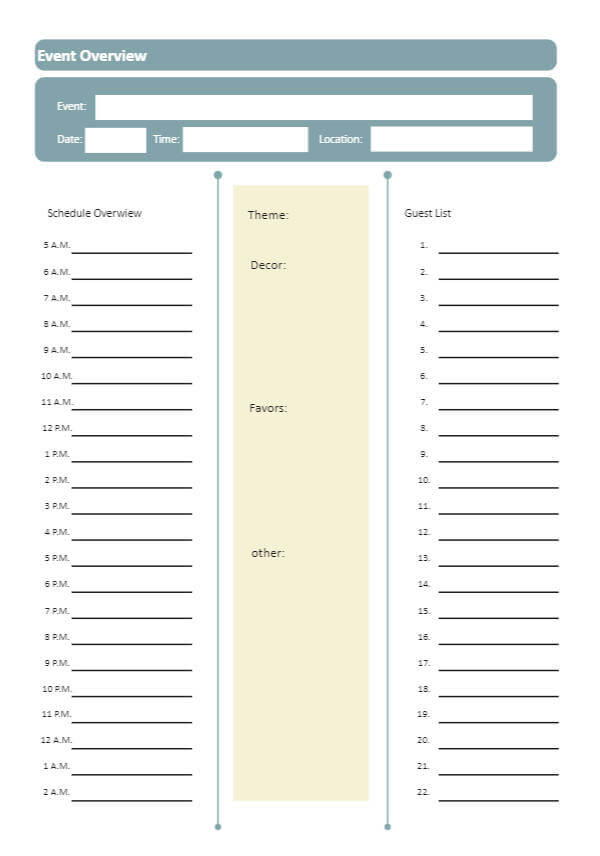
An event timeline helps you out with event planning. It lists all the tasks and activities to complete before the event, and it tells you when the event takes place and the aftermath of the event. If you are planning an event and are stuck because you can't figure out the perfect order for completing all tasks, then having an event timeline will save you a lot of trouble. It makes your job easy by helping you keep track of what you have already done and what remains.
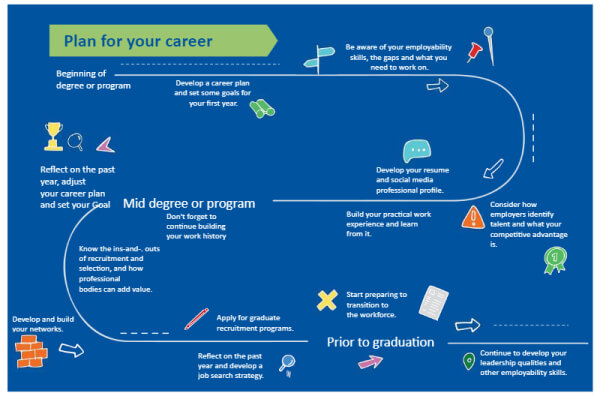
A career timeline is an excellent tool to plan out each step of your career. If you like future planning and to have a successful career, then make sure to create a career timeline that describes the six phases of your life as a professional. You can start by listing your college studies and list your graduation and various training programs for the job you want. Make a roadmap and list your promotions and various events till you retire. Having a plan is always better than making random choices and taking risks.
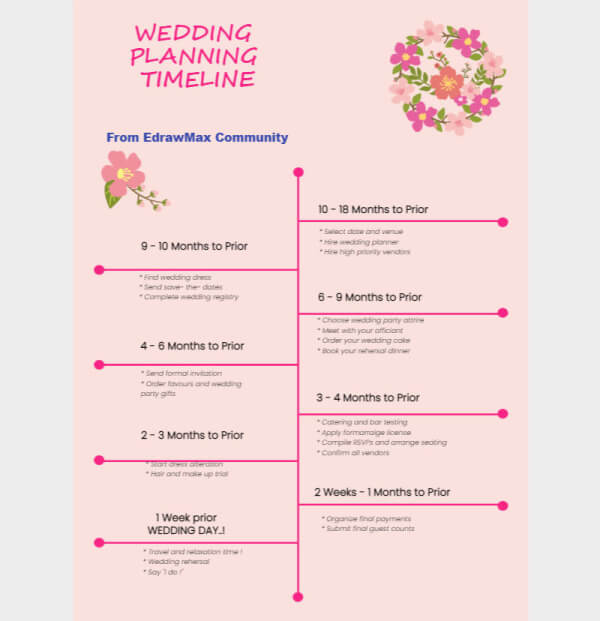
When planning out a wedding, making a wedding timeline will make it easy for you to organize all the small events and tasks and help you go over your wedding plan. A wedding timeline usually starts with picking the weekend for the wedding, and each event is part of the timeline, from finding the venue to starting the rehearsal dinner. Mark the wedding ceremony the next day and the brunch. It also helps you figure out what the guests will be doing and when the dance will begin.
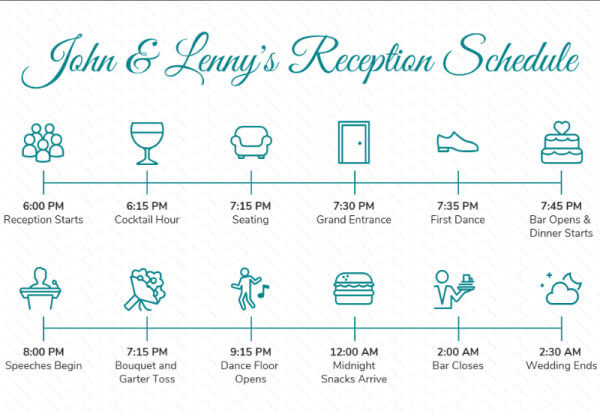
A reception timeline describes each event that will be part of a wedding reception. At the start of the timeline, you can mark the arrival of guests and the cocktail hour. After the cocktail hour ends, you can mark the dinner invitation. After a few minutes, the couple enters, and the welcome toast starts. You can list the time for parent’s dances and the end of the reception at the end.
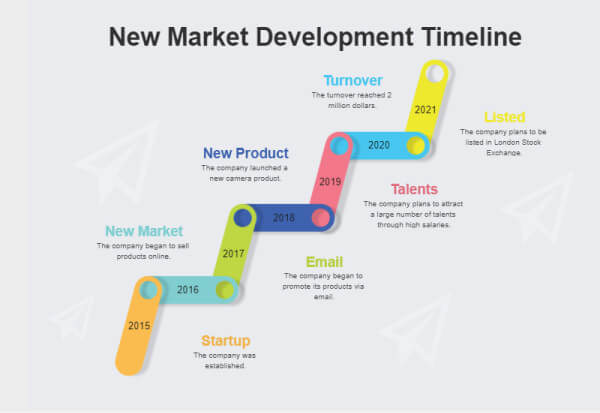
A marketing timeline helps you create a perfect marketing plan and keep track of the strategies you have already used and your completed goals. With marketing time, you can plan each step and element of your marketing strategy. It gives you a precise schedule to follow and describe your objectives in chronological order. You can even mark the successful marketing plans and the ones that gave you the least output. You can use a roadmap or a Gantt chart to create a marketing timeline.

A ceremony timeline helps you figure out each step of your wedding day in a chronology. You can use the traditional wedding ceremony format if you don't have anything special planned for the big day. You can start with preparing the processional and the arrival of the groom and bride. The next is to welcome all the guests and begin reading the vows. The ceremony ends with the couple being pronounced husband and wife.
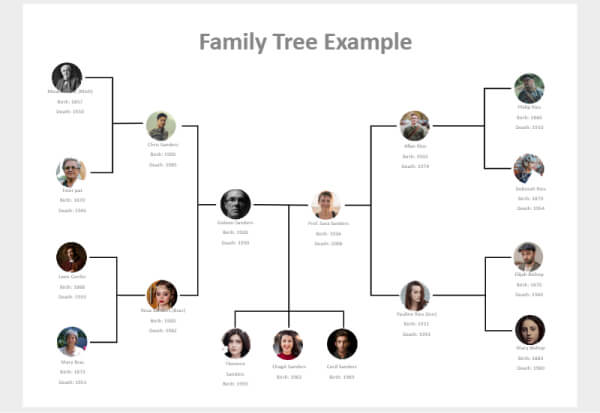
A family timeline visually represents the important events related to your closely related family members. You can create a family timeline by listing all of your family members or using a family tree. Add some details about the history of your family members, such as their jobs and their achievements. Start adding your info, like the big moments in your life and your career. You can also use photos in the family timeline to mark the event you want to remember forever.
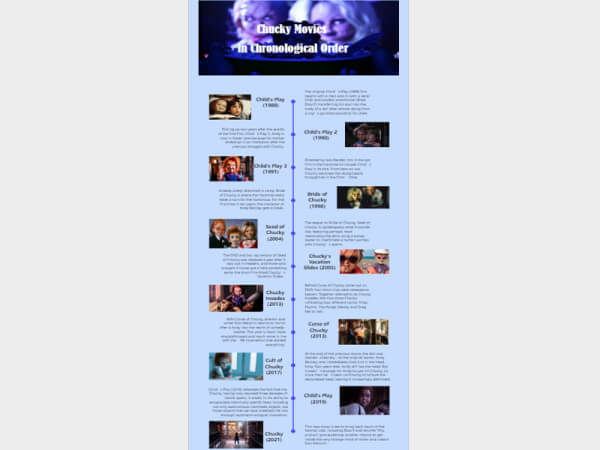
There are many movies with sequels and prequels taking place at different times compared to the original story. With a movie timeline, you can list each part of the movie based on the actual chronology or the release of each piece. It will help the reader better understand the movie's main plot and storyline. Movie timelines are essential when the production makes the prequels after the main story.
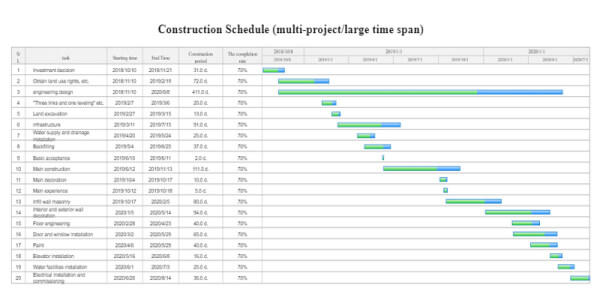
Being a construction manager, you have to make lots of important decisions and figure out the ideal chronology to plan each step of construction. The best way to plan a remodelling or construction of a house or a building is to divide tasks and give each task a deadline. This way, the workers will know when to complete each task, and the construction will carry out as planned and finish in the given time.
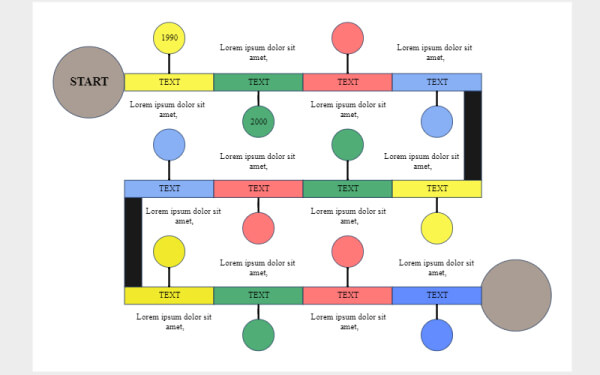
A graphical timeline illustrates the chronological order of events or tasks over a given period in time. You can do lots of things with a timeline. It helps you figure out the ideal time period for an event. You can use it to depict historical events and explain the biography of historical figures. A graphical timeline uses the format of a Gantt chart or a bar chart. Each bar separates into a smaller section of various colours to represent different tasks and elements.
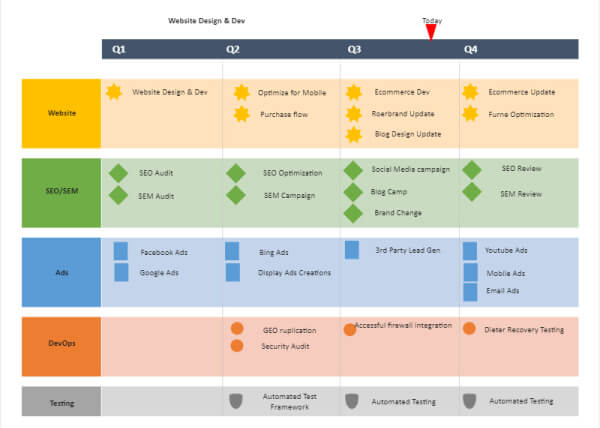
A website timeline come in handy when creating a website. It describes each step and task part of the website project management. It gives the developer a general idea of the amount of time needed to complete each task based on its complexity. There is various small task in each listed task of the timeline. When everything is complete, the website enters the testing phase before it goes to the user.

How do Timelines Visualize Data: Learn from Timeline Examples
Need some inspiration for your visualization project? Take a cue from some of our selected templates and examples!
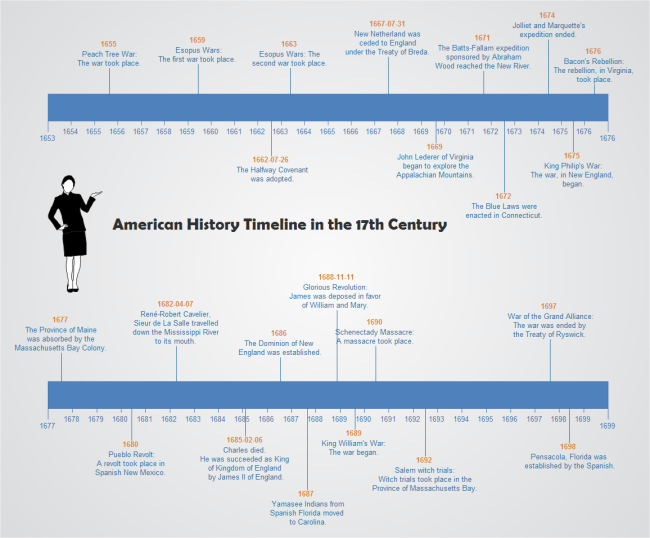
Historical timelines, like the one above, revolve around events and their dates. They can be about war records, ancient civilizations, royal families, biographies and so on. Sometimes, you can add citations, notes, and other associated information according to your needs. Usually, these charts look simplistic, like an orderly list. While students find it difficult to remember the dates of historical events on history books, they can turn to a timeline like this for help, because it creates a greater impact on dates and events. These are widely used by teachers as study material or be a project of actual historians. In many ways, this type of template is highly speculated at various stages of academia, whether junior school level or higher studies.

The software goes through the constant integration process, and the different versions are tracked in a versions timeline. This content generally uses a vertical, cascading layout, with colored bars used to indicate the status and other details about particular versions concisely. However, it can also be done on an interactive template. The latest update may be at the top of the page or bottom, as per the creator’s choice.
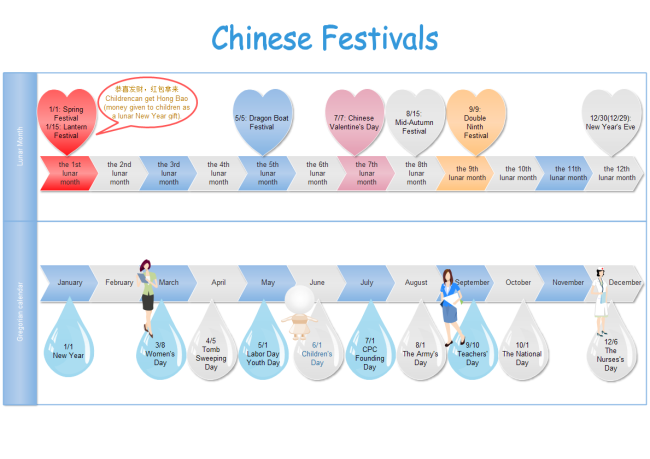
This is a custom template, which has been made into a timeline about Chinese Festivals, public holidays and occasions, including Women’s Day. This can be ideal for putting up on Office Bulletin Board or shared in an open platform. Take a pointer, if you have a cluster of dates to showcase, either festival or showtimes, or time tables, a minimalistic and pastel color-coded visualization like this is a grand idea.
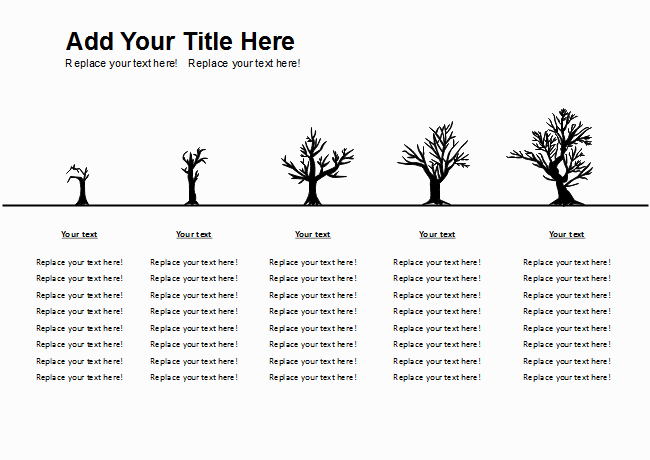
A new project. A non-profit venture. Or just a startup business. If you are aiming for growth, Make A Statement! You don’t need too much content, don’t need too many graphical elements. Keep it simple and powerful.
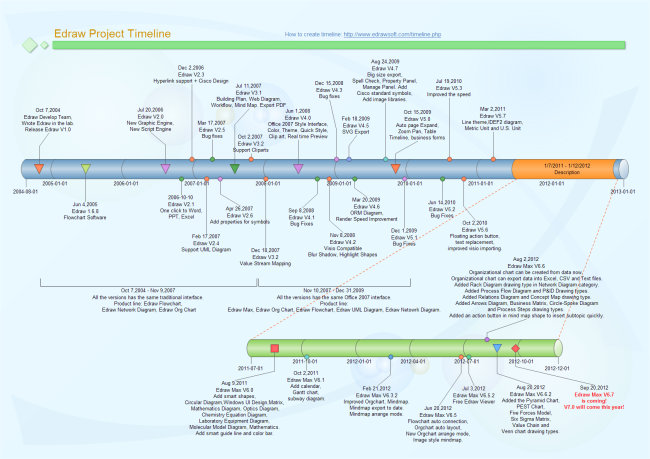
Track the multifaceted courses of your project. Take a cue from this old project version history of EdrawMax. Start from scratch and work your way to the top by consistently adding new data. Keep it as clean as possible.
How to Create an Eye-catching Timeline with EdrawMax?
Are you ready to start working on your project? Let us read about this simple step-by-step guide.
- Select one template that is tailored to your topic.
- Drag and drop the symbols and shapes that you need and add your own contents.
- If you want to make custom timeline, feel free to customize every detail of your timeline.
- Moreover, you can add images from your local disk if you need.
- Once you are done, you can choose to export your work to many common files, share it on social media or print out a high-quality timeline.
Here you can find detailed steps of how to create a timeline.
Related Articles


Extended Essay: Step 6. Create a Timeline
- Extended Essay- The Basics
- Step 1. Choose a Subject
- Step 2. Educate yourself!
- Using Brainstorming and Mind Maps
- Identify Keywords
- Do Background Reading
- Define Your Topic
- Conduct Research in a Specific Discipline
- Step 5. Draft a Research Question
- Step 6. Create a Timeline
- Find Articles
- Find Primary Sources
- Get Help from Experts
- Search Engines, Repositories, & Directories
- Databases and Websites by Subject Area
- Create an Annotated Bibliography
- Advice (and Warnings) from the IB
- Chicago Citation Syle
- MLA Works Cited & In-Text Citations
- Step 9. Set Deadlines for Yourself
- Step 10. Plan a structure for your essay
- Evaluate & Select: the CRAAP Test
- Conducting Secondary Research
- Conducting Primary Research
- Formal vs. Informal Writing
- Presentation Requirements
- Evaluating Your Work
Plan, Plan, Plan!
You are expected to spend approximately 40 hours on the whole extended essay process. You will have to be proactive in organizing and completing different tasks during those stages.
Using the Extended Essay Timeline you should prepare your own personal timeline for the research, writing, and reflection required for your EE.

Twelve-step Plan for Researching the Extended Essay - Step 6
6. Draw up an outline plan for the research and writing process. This should include a timeline.

- << Previous: Step 5. Draft a Research Question
- Next: Step 7. Identify & Annotate Sources >>
- Last Updated: May 8, 2024 3:48 PM
- URL: https://libguides.westsoundacademy.org/ee
University Library
Creating timelines with knightlab.
- Create a Timeline
- Embed it in a Website
- Online Reference (encyclopedias & quickfacts)
- Find Images & Historical Materials
- Find Articles
Citation for Digital Projects
Citation help links.
- Link to Library Resources
- Titanic Digital Timeline Example Wondering how to cite in a timeline? Here's a timeline with citations for text entries (in-text), for images, and at the end of your timeline (works cited).
Using an image like the one below from ArtSTOR? Cite it.
- Let us know where you got the copyrighted image by citing it below the image.

Using an image you found for free on the web? Cite it.
- Let us know where you got the copyright-free image by writing "Image from Pixabay" or "Pixabay" below the image!
When in doubt, cite!
- MLA Works Cited Quick Guide A 2-page PDF quick guide to MLA style with sample citations by type of source.
- MLA Citation: Writing & Citing Guide (links out) Self-help for creating MLA and other types (APA, Chicago) of citations for research papers.
- CSULB's MLA Style Guide (color-coded; links out) A very detailed and color-coded MLA style guide created by the Literature Librarian at CSU Long Beach. Includes works cited and in-text citation examples.
- << Previous: Find Articles
- Next: Link to Library Resources >>
- Last Updated: Jan 17, 2024 10:27 AM
- URL: https://libguides.calstatela.edu/c.php?g=1124920

How to write an introduction for a history essay

Every essay needs to begin with an introductory paragraph. It needs to be the first paragraph the marker reads.
While your introduction paragraph might be the first of the paragraphs you write, this is not the only way to do it.
You can choose to write your introduction after you have written the rest of your essay.
This way, you will know what you have argued, and this might make writing the introduction easier.
Either approach is fine. If you do write your introduction first, ensure that you go back and refine it once you have completed your essay.
What is an ‘introduction paragraph’?
An introductory paragraph is a single paragraph at the start of your essay that prepares your reader for the argument you are going to make in your body paragraphs .
It should provide all of the necessary historical information about your topic and clearly state your argument so that by the end of the paragraph, the marker knows how you are going to structure the rest of your essay.
In general, you should never use quotes from sources in your introduction.
Introduction paragraph structure
While your introduction paragraph does not have to be as long as your body paragraphs , it does have a specific purpose, which you must fulfil.
A well-written introduction paragraph has the following four-part structure (summarised by the acronym BHES).
B – Background sentences
H – Hypothesis
E – Elaboration sentences
S - Signpost sentence
Each of these elements are explained in further detail, with examples, below:
1. Background sentences
The first two or three sentences of your introduction should provide a general introduction to the historical topic which your essay is about. This is done so that when you state your hypothesis , your reader understands the specific point you are arguing about.
Background sentences explain the important historical period, dates, people, places, events and concepts that will be mentioned later in your essay. This information should be drawn from your background research .
Example background sentences:
Middle Ages (Year 8 Level)
Castles were an important component of Medieval Britain from the time of the Norman conquest in 1066 until they were phased out in the 15 th and 16 th centuries. Initially introduced as wooden motte and bailey structures on geographical strongpoints, they were rapidly replaced by stone fortresses which incorporated sophisticated defensive designs to improve the defenders’ chances of surviving prolonged sieges.
WWI (Year 9 Level)
The First World War began in 1914 following the assassination of Archduke Franz Ferdinand. The subsequent declarations of war from most of Europe drew other countries into the conflict, including Australia. The Australian Imperial Force joined the war as part of Britain’s armed forces and were dispatched to locations in the Middle East and Western Europe.
Civil Rights (Year 10 Level)
The 1967 Referendum sought to amend the Australian Constitution in order to change the legal standing of the indigenous people in Australia. The fact that 90% of Australians voted in favour of the proposed amendments has been attributed to a series of significant events and people who were dedicated to the referendum’s success.
Ancient Rome (Year 11/12 Level)
In the late second century BC, the Roman novus homo Gaius Marius became one of the most influential men in the Roman Republic. Marius gained this authority through his victory in the Jugurthine War, with his defeat of Jugurtha in 106 BC, and his triumph over the invading Germanic tribes in 101 BC, when he crushed the Teutones at the Battle of Aquae Sextiae (102 BC) and the Cimbri at the Battle of Vercellae (101 BC). Marius also gained great fame through his election to the consulship seven times.
2. Hypothesis
Once you have provided historical context for your essay in your background sentences, you need to state your hypothesis .
A hypothesis is a single sentence that clearly states the argument that your essay will be proving in your body paragraphs .
A good hypothesis contains both the argument and the reasons in support of your argument.
Example hypotheses:
Medieval castles were designed with features that nullified the superior numbers of besieging armies but were ultimately made obsolete by the development of gunpowder artillery.
Australian soldiers’ opinion of the First World War changed from naïve enthusiasm to pessimistic realism as a result of the harsh realities of modern industrial warfare.
The success of the 1967 Referendum was a direct result of the efforts of First Nations leaders such as Charles Perkins, Faith Bandler and the Federal Council for the Advancement of Aborigines and Torres Strait Islanders.
Gaius Marius was the most one of the most significant personalities in the 1 st century BC due to his effect on the political, military and social structures of the Roman state.
3. Elaboration sentences
Once you have stated your argument in your hypothesis , you need to provide particular information about how you’re going to prove your argument.
Your elaboration sentences should be one or two sentences that provide specific details about how you’re going to cover the argument in your three body paragraphs.
You might also briefly summarise two or three of your main points.
Finally, explain any important key words, phrases or concepts that you’ve used in your hypothesis, you’ll need to do this in your elaboration sentences.
Example elaboration sentences:
By the height of the Middle Ages, feudal lords were investing significant sums of money by incorporating concentric walls and guard towers to maximise their defensive potential. These developments were so successful that many medieval armies avoided sieges in the late period.
Following Britain's official declaration of war on Germany, young Australian men voluntarily enlisted into the army, which was further encouraged by government propaganda about the moral justifications for the conflict. However, following the initial engagements on the Gallipoli peninsula, enthusiasm declined.
The political activity of key indigenous figures and the formation of activism organisations focused on indigenous resulted in a wider spread of messages to the general Australian public. The generation of powerful images and speeches has been frequently cited by modern historians as crucial to the referendum results.
While Marius is best known for his military reforms, it is the subsequent impacts of this reform on the way other Romans approached the attainment of magistracies and how public expectations of military leaders changed that had the longest impacts on the late republican period.
4. Signpost sentence
The final sentence of your introduction should prepare the reader for the topic of your first body paragraph. The main purpose of this sentence is to provide cohesion between your introductory paragraph and you first body paragraph .
Therefore, a signpost sentence indicates where you will begin proving the argument that you set out in your hypothesis and usually states the importance of the first point that you’re about to make.
Example signpost sentences:
The early development of castles is best understood when examining their military purpose.
The naïve attitudes of those who volunteered in 1914 can be clearly seen in the personal letters and diaries that they themselves wrote.
The significance of these people is evident when examining the lack of political representation the indigenous people experience in the early half of the 20 th century.
The origin of Marius’ later achievements was his military reform in 107 BC, which occurred when he was first elected as consul.
Putting it all together
Once you have written all four parts of the BHES structure, you should have a completed introduction paragraph. In the examples above, we have shown each part separately. Below you will see the completed paragraphs so that you can appreciate what an introduction should look like.
Example introduction paragraphs:
Castles were an important component of Medieval Britain from the time of the Norman conquest in 1066 until they were phased out in the 15th and 16th centuries. Initially introduced as wooden motte and bailey structures on geographical strongpoints, they were rapidly replaced by stone fortresses which incorporated sophisticated defensive designs to improve the defenders’ chances of surviving prolonged sieges. Medieval castles were designed with features that nullified the superior numbers of besieging armies, but were ultimately made obsolete by the development of gunpowder artillery. By the height of the Middle Ages, feudal lords were investing significant sums of money by incorporating concentric walls and guard towers to maximise their defensive potential. These developments were so successful that many medieval armies avoided sieges in the late period. The early development of castles is best understood when examining their military purpose.
The First World War began in 1914 following the assassination of Archduke Franz Ferdinand. The subsequent declarations of war from most of Europe drew other countries into the conflict, including Australia. The Australian Imperial Force joined the war as part of Britain’s armed forces and were dispatched to locations in the Middle East and Western Europe. Australian soldiers’ opinion of the First World War changed from naïve enthusiasm to pessimistic realism as a result of the harsh realities of modern industrial warfare. Following Britain's official declaration of war on Germany, young Australian men voluntarily enlisted into the army, which was further encouraged by government propaganda about the moral justifications for the conflict. However, following the initial engagements on the Gallipoli peninsula, enthusiasm declined. The naïve attitudes of those who volunteered in 1914 can be clearly seen in the personal letters and diaries that they themselves wrote.
The 1967 Referendum sought to amend the Australian Constitution in order to change the legal standing of the indigenous people in Australia. The fact that 90% of Australians voted in favour of the proposed amendments has been attributed to a series of significant events and people who were dedicated to the referendum’s success. The success of the 1967 Referendum was a direct result of the efforts of First Nations leaders such as Charles Perkins, Faith Bandler and the Federal Council for the Advancement of Aborigines and Torres Strait Islanders. The political activity of key indigenous figures and the formation of activism organisations focused on indigenous resulted in a wider spread of messages to the general Australian public. The generation of powerful images and speeches has been frequently cited by modern historians as crucial to the referendum results. The significance of these people is evident when examining the lack of political representation the indigenous people experience in the early half of the 20th century.
In the late second century BC, the Roman novus homo Gaius Marius became one of the most influential men in the Roman Republic. Marius gained this authority through his victory in the Jugurthine War, with his defeat of Jugurtha in 106 BC, and his triumph over the invading Germanic tribes in 101 BC, when he crushed the Teutones at the Battle of Aquae Sextiae (102 BC) and the Cimbri at the Battle of Vercellae (101 BC). Marius also gained great fame through his election to the consulship seven times. Gaius Marius was the most one of the most significant personalities in the 1st century BC due to his effect on the political, military and social structures of the Roman state. While Marius is best known for his military reforms, it is the subsequent impacts of this reform on the way other Romans approached the attainment of magistracies and how public expectations of military leaders changed that had the longest impacts on the late republican period. The origin of Marius’ later achievements was his military reform in 107 BC, which occurred when he was first elected as consul.
Additional resources

What do you need help with?
Download ready-to-use digital learning resources.

Copyright © History Skills 2014-2024.
Contact via email
Project Management
7 minute read
How to Create a Timeline for a Project (and Why They Matter)

Anita Sambol
Facebook Twitter LinkedIn WhatsApp Email
You know what it's like: A deadline gets missed, your team gets flustered, and you all fall behind. Targets are missed, and opportunities are lost. In short, you've dropped the ball.
Well, one of the reasons might be that you haven't created a clear action plan in the form of a project management timeline.
In this article, we're going to outline the importance of a project management timeline, before giving you a step-by-step tutorial on how to create one. This means no more missed deadlines and much more productivity.
Let's take a look!
Want to be a successful project manager?
Get your free ebook covering the six major aspects all project managers should know!
The importance of timelines in project management
There are numerous benefits to creating a clear project management timeline. These include:
Improved communication
A study by Cortex found that 57% of projects fail due to poor communication between team members. This shows how crucial it is to have a communication strategy implemented into project management, which can be easily defined with timelines.
A project management timeline improves communication so that everyone knows who is doing what. Moreover, it allows other team members to get involved quickly and efficiently when it comes to relaying the right information to the right team members.
Not just that, but by improving communication , you're also improving morale. A study by Accountemps found that 33% of respondents believe inadequate communication from management is the primary cause of morale issues in the workplace.

Project progress can more easily be tracked
Let's say you do happen to fall behind schedule with a project. While that's a bummer, the advantage of a project management timeline is that you can recognize when you've fallen behind a due date as soon as possible. This means you can react as quickly as possible, too.
Better time management
Time has a starring role in the success of any project. When you properly plan your project with a timeline, you get to understand how damaging a delay can be. When you have an overall view of the progress in front of you, it's easier to avoid working mindlessly on tasks. Instead, your team will focus each week on what needs to get done.
Improved motivation
Motivation can be the driving force behind a project. Some team members find it easier to stay motivated when they can see a timeline in front of them as it helps to sharpen their focus and discipline. Motivation also goes up when they can see they're completing their tasks on time (or even ahead of time).
Important tasks get done first
With a project, you have to be flexible. Priority tasks change often, and it's essential that you know what needs doing before anything else.
A timeline helps to set clear priorities and directions so that the most critical tasks are cleared out of the way first.
How to create a timeline for a project
Creating a project management timeline doesn't have to be stressful. Here's the best way to do it:
1. Outline your goals
Before you begin, it's crucial that you know what your goals are - and also that your team mutually agrees on your overall goals and their individual goals for each project. Get approval from everyone for each target before moving forward so that there are no misunderstandings later on.
2. Note down key milestones
Milestones are a fantastic way to help you schedule, plan, and evaluate your project as it moves along. A milestone might include delivered work, a phase in the project, an approval, or even a meeting.
Essentially, a milestone should be an actionable step that brings you closer to your overall goal. Moreover, they're great ways to break your project down so that it doesn't look overwhelming, and they also help you to create a timeline.

3. Decide timeframes
For this one, you'll need to find who's available for your project and what their workloads are like. This is vital information that will help you create a project timeline and decide on timeframes for each milestone.
After all, the last thing you and your team want is for an unreasonable time frame to create tension.
Don't underestimate or overestimate your team's capacity. Talk to your peers about their workload and abilities, so milestones aren't missed, and opportunities aren't lost.
4. Review everything
Before launching your project management timeline, everyone must be on board with it. This includes yourself, your team, and your clients.
Present a draft roadmap of your project timeline to your team and ask for opinions. Are their milestones present? Does anything need adding? Does the timeframe look too crowded? Does it need to be slimmed down?
Show your timeline to your clients/stakeholders, too. While you might not need to show them the whole thing, it's a good idea to get them to confirm the delivery dates and milestones.
5. Create your project management timeline
When it comes to the creation of your project management timeline, it's a good idea to use a project planning tool . Such a tool will help you manage your tasks and budget, and it will also help you to plan your project properly.
It will also make it easier for you to develop an actionable project timeline that looks the way you want it to. If you're stuck for inspiration regarding how your timeline should look, you can use project management templates , too.
On the other hand, you could use an Excel project template, which is free. However, they're not as flexible as premium tools and might not be the best for complicated projects.
6. Track and analyze
The great thing about a project management timeline is that it can be tracked, analyzed, and improved upon. If something isn't working the way you wanted it to, you can revisit it and make amendments while communicating everything to your team members.
Ask each member of your team to mark their progress in real-time, but make sure to find a method that works for you guys.
Conclusion
Now that you know how to create a timeline for a project, the next step is to take action. The importance of timelines in project management can't be underestimated; follow the step-by-step guide in this article for more efficient, productive, and ultimately successful projects from now on.
With GoSkills Project Management for Experts course, you will learn how the pros create timelines, stay on track, and so much more!
Start learning today with a seven day free trial of all GoSkills courses.
Prepare to get certified in project management
Start learning today with GoSkills courses
Loved this? Subscribe, and join 453,630 others.
Get our latest content before everyone else. Unsubscribe whenever.

Anita Sambol is a passionate writer currently working with Teamdeck. She has years of experience in content creation and freelancing. In her free time, she enjoys cooking and watching football.

Recommended
How Can AI Enhance Project Management?
These 7 applications of artificial intelligence can lead to greater productivity and project outcomes.

10 Strategies for Managing Multiple Projects (+Practical Solutions)
Get practical suggestions from the experts on how to make managing multiple projects a breeze.

Project Management for Travel Agencies: The Ultimate Guide
Project management is crucial for travel agency success. It is vital for travel agents at all levels to master project-based work.
© 2024 GoSkills Ltd. Skills for career advancement
How To Write A Timeline Essay
The sample essay on How To Write A Timeline Essay deals with a framework of research-based facts, approaches and arguments concerning this theme. To see the essay’s introduction, body paragraphs and conclusion, read on.
The internet is a handy resource to everyone, especially the student who has a full educational schedule and a busy life outside of the academic arena. It is also helpful to professional educators and parents of students. However, along with all of the valid resources on the internet there is an equal amount of invalid material.
The users of the internet need to be able to evaluate a website and determine the accuracy of a site. Kim’s Korner for Teacher Talk is a website that was developed by educator, Kim Steele and even though it states that it is for everyone of all ages, (Steele) the target audience is parents, students, and other teachers. Through this website, it will be explained how a website should be evaluated for its validity.
Kim’s Korner for Teacher Talk has a page that is the writing process and a timeline that she uses with her students to make sure that they are on task. She understands that “Writing is a process, not merely a product.” (OWL) Her students accumulate points for each step of the process and they have a time frame in which they must complete their work. The objective for creating the timeline is to keep her students focused and to make sure that writing is not difficult and overwhelming.

Proficient in: Writing
“ Thank you so much for accepting my assignment the night before it was due. I look forward to working with you moving forward ”
By dividing the assignment into stages, a student will realize quickly if there is a problem with the topic chosen for the writing assignment.
Kim’s Korner 4 Teachertalk
The sample timeline offers nine steps during the writing process. Understanding process helps us recognize where a student writer is in his or her process and offer help appropriate to that phase. (Trupe). Kim states that the website is for all ages, but it seems to be geared toward elementary students because of the graphics that she uses. With some tweaking, the timeline could be used for any educational level. The first thing one would want to do if he/she were using this with older students is to remove the graphics, and perhaps using diction that is more academic.
The timeline that is designed by Kim is geared to allow students to have a time frame in which steps in the writing process are due and when the final draft is due. To many students this would be beneficial. The student who procrastinates can obviously understand that he/she cannot delay the assignment until the night before the final draft is due. It would also assure the teacher that all of the steps are used by the student. Many times students will delay doing their assignment and they will rush through it at the last minute. This often times leads to poor quality work. If the teacher uses the timeline, he/she will be assured that this will not happen.
Good writing habits do not just happen. They must be practiced like a sport or musical instrument. The longer one practices, the better he/she becomes at the task. If the teacher uses this timeline for a long period of time, the student will eventually internalize the writing process so that in later on when the student is no longer in the class of the teacher using it, he/she will automatically go through the steps of the writing process. This is a useful tool for the teacher to share his/her own writing experiences. He/She should be able to discuss how he/she has benefited from using the writing process. A child believes a teacher has no life beyond the classroom. A teacher is the face in the front of the room, the person who hands out assignments and issues grades. Where she came from, or how she got there, doesn’t register. (Hallman)
Another positive aspect of the timeline is that the teacher is involved in each step. He/She should be checking the assignment at each due date which will guarantee that the students are accurate in what they are doing for the assignment. If there are problems, the teacher can intervene early on instead of catching the problem at the very end. If a conversational tone is used with the student, then h/she will not feel threatened or intimidated.
How can teachers view writing assessment as a conversation? First, pay attention to what goes on in your mind as you read students’ writing, and articulate those reactions; give each student your experience of reading her or his paper. As students respond to your reactions, you might find that your interpretation and suggestions change. Be open to each writer’s purposes, experiences, and personality, using everything you know about that person and yourself as a reader. (Wilson)
This would be frustrating to a student who had put a lot of time into an assignment that was not acceptable. The student would then loose points for the daily assignments as well as many points on the final draft. That would lead to failure and frustration for the student. However, the timeline would alert the teacher to the problem while it was a small one instead of a huge one.
The timeline includes a two brainstorming sessions which is a positive aspect for the students. The first brainstorming session would allow for the student to choose a topic. Many times this is the hardest step. Almost everyone has at one time or another stared at a blank piece of paper or computer screen for a long time because he/she is utterly clueless about which topic to choose. The first brainstorming session would insure that this did not happen to the students. The second session of brainstorming would aid the students in narrowing their topic. There are many times that students will choose a topic that is too broad. When a topic is broad, it would take enough information to fill a book to cover it. Instead, this second brainstorming session, with the help of graphic organizers, would alleviate the problem.
Once the first draft is written, there is an opportunity for revising for coherence, writing a second draft, and editing for usage and mechanics. These steps might seem time consuming, but in the long run they are beneficial. Students’ final drafts will be much better if these steps are followed. Peer revision for coherence is used after the first draft is written. The process of student self-assessment through rubrics can be enhanced with peer assessment and teacher feedback, of course. (Andrade). This step allows another student to read the assignment for clarity. Using peers for this evaluation is actually better than a teacher because the peer is the targeted audience therefore, less biased. The student can then understand where there is no clarity and he/she then revises the assignment by writing the second draft. The paper then goes through peer editing to check for usage and mechanic problems with the paper. This is done separately from the first peer conference so that the student can concentrate on one area at a time and so that the writer is not overwhelmed with the number of mistakes found on the paper. The student should also use self-assessment during the peer revision and editing steps. Even though the peer is useful in giving objective criticism, the peer is also a student like the writer.
During self-assessment, students reflect on the quality of their work, judge the degree to which it reflects explicitly stated goals or criteria, and revise. Self-assessment is formative — students assess works in progress to find ways to improve their performance. Self-evaluation, in contrast, is summative — it involves students giving themselves a grade (Andrade)
Even though the writing process designed and used by Kim is beneficial for most students, there are some that it would hinder success. While it would greatly help a student with an attention deficit disorder because the student would not be focused on one aspect of the writing process for a long time, it could be overwhelming to a student who has other learning disabilities. When a student has a learning disability in written expression sees the amount of time that he/she will be working on a task that is a disability to him/her, then the student is likely to give up before he/she even starts the assignment. It would also frustrate that student to see that so many points were allotted to an assignment that is already difficult for him/her. Embarrassment is another problem when it comes to peer revision and editing. For a student with no learning disability, the chance that his/her paper is not totally full of mistakes is not a problem. However, the student with a problem in written expression would see peer revision and editing in a totally different light. Not only would the embarrassment frustrate the student, but the time constraints could be a horrible blow. The only way that the writing process timeline could work with this student would be if the due dates were revised for that student.
After closely analyzing the website Kim’s Korner for Teacher Talk, the conclusion is that the website is a positive one and the information presented would be of great benefit for most teachers. However, the students with learning disabilities in written expression should be taken into account. If the teacher forgets about these students and does not make major adjustments to the writing process timeline, these students will be doomed for failure.
Cite this page
How To Write A Timeline Essay. (2019, Dec 07). Retrieved from https://paperap.com/paper-on-essay-kims-writing-process-timeline-2/
"How To Write A Timeline Essay." PaperAp.com , 7 Dec 2019, https://paperap.com/paper-on-essay-kims-writing-process-timeline-2/
PaperAp.com. (2019). How To Write A Timeline Essay . [Online]. Available at: https://paperap.com/paper-on-essay-kims-writing-process-timeline-2/ [Accessed: 1 Jun. 2024]
"How To Write A Timeline Essay." PaperAp.com, Dec 07, 2019. Accessed June 1, 2024. https://paperap.com/paper-on-essay-kims-writing-process-timeline-2/
"How To Write A Timeline Essay," PaperAp.com , 07-Dec-2019. [Online]. Available: https://paperap.com/paper-on-essay-kims-writing-process-timeline-2/. [Accessed: 1-Jun-2024]
PaperAp.com. (2019). How To Write A Timeline Essay . [Online]. Available at: https://paperap.com/paper-on-essay-kims-writing-process-timeline-2/ [Accessed: 1-Jun-2024]
- English Poetry Timeline Pages: 2 (433 words)
- Paul Revere Timeline Pages: 5 (1371 words)
- Bill Gates-Computer Timeline Pages: 4 (1013 words)
- Historical Development of Nursing Timeline Pages: 14 (4106 words)
- Kinesiology Timeline Outline Pages: 6 (1769 words)
- Science & Gender: A Timeline of Inequality Pages: 6 (1765 words)
- History Timeline Project Pages: 9 (2499 words)
- How To Write An Argumentative Essay Pages: 5 (1294 words)
- Write An Essay On Colonialism And Imperialism Pages: 5 (1312 words)
- A Guide for Students How to Write a Dialectical Essay Pages: 5 (1206 words)
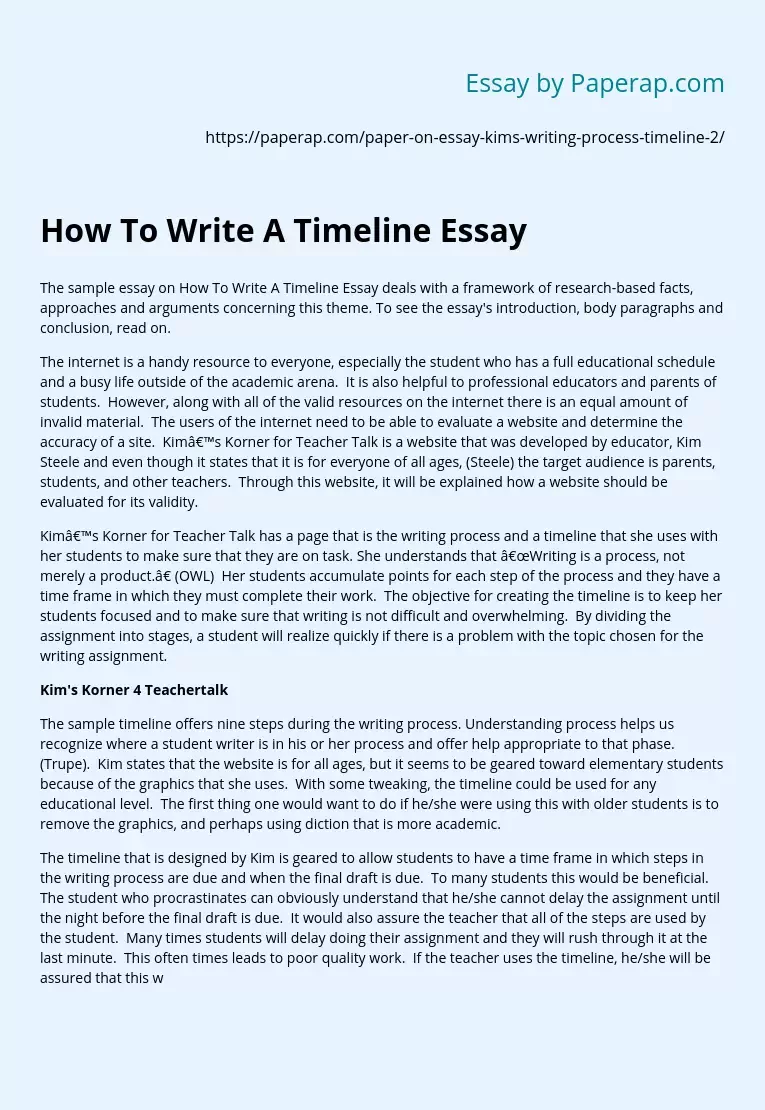
Travis Kelce Is Reportedly ‘Arranging His Schedule’ to Be With Taylor Swift in Europe as Much as He Can

Every item on this page was chosen by an ELLE editor. We may earn commission on some of the items you choose to buy.
“He wants to support her as much as he can while he can, so he’s going to [go] back and forth from the U.S. to Europe while he has the time,” the source said. Swift and Kelce, who just vacationed in Lake Como, Italy , after her Paris shows , are having a “wonderful time in Europe so far.” Kelce flew back to Kansas City, Missouri, after the Italy trip and hosted Kelce Jam there last weekend.
He also already wrapped filming for his role on Ryan Murphy’s upcoming series Grotesquerie, Us Weekly reported. A second source said on May 23 that Kelce “had an incredible time” and found it “surprising” that he even got the offer to join the show.
With that work commitment behind him, he “can arrange his schedule to be with [Taylor],” the first source said. That insider added that he and Swift plan to do some home décor shopping in Europe: “They love going antique shopping, and she’s been helping him pick out some things for his new house in Kansas.”
Taylor's ‘Tortured Poets’ Songs Rumored to be About Travis

Taylor Swift Doesn’t Hide the Travis Kelce References in ‘The Alchemy’
Swift literally uses the phrase “touch down” in this song about a love that happens “once every few lifetimes.” Read the lyrics.

Taylor Swift’s ‘The Albatross’ Lyrics Seemingly Reveal the Warnings Travis Kelce Got About Her
Fans theorize this song captures the beginning of Swift and Kelce’s relationship and how they coped with public scrutiny.

Taylor Swift Sings About Wanting to Marry Travis Kelce in ‘So High School’
Swift is not subtle about her feelings about Kelce and their high school-like romance in this love song’s lyrics.
Kelce also has a reason beyond Swift to be abroad: Page Six reported yesterday that Kelce and his brother, Jason, will be doing an episode of their podcast, New Heights , at the Cannes Lion International Festival of Creativity in France on June 20.
Swift will be playing in the U.K. around that time, meaning Kelce could join her in London after . Her shows there begin on June 21.
Go Even Deeper on Taylor Swift

Travis Kelce and Taylor Swift’s Full Relationship Timeline
How their whirlwind romance took off, from podcast shoutout to Super Bowl kiss.

Taylor Swift’s 30 Things I Learned Before Turning 30
Read Swift’s candid essay for ELLE about the life lessons she learned before hitting that milestone year.

Taylor Swift and Joe Alwyn’s Complete Relationship Timeline
Swift spent six years dating Alwyn. Revisit the history that Tortured Poets is expected to explore.
Celebrity News 2024

Julia Fox’s Complete Dating History

All About Blue Ivy Carter

All About Lola Consuelos, Kelly Ripa’s Daughter

Why Harry Styles and Taylor Russell Broke Up
Ryan Reynolds on His Lasting Marriage with Blake

Selena on Benny’s Comments About Their Future

Why Travis Kelce Remained in the U.S. This Weekend
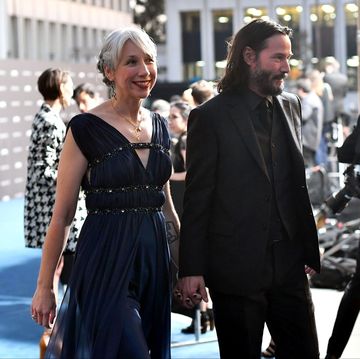
All About Keanu Reeves’ Girlfriend

All About Sophia Bush’s Girlfriend Ashlyn Harris

All About Shay's Boyfriend Matte Babel
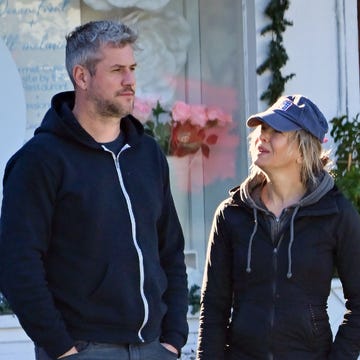
Renée Zellweger and Ant Anstead’s Love Story
- Share full article
Advertisement
Supported by
She Made an Offer on a Condo. Then the Seller Learned She Was Black.
A Black woman claims a white homeowner tried to pull out of a sale because of her race.

By Debra Kamin
Perched on a hill with a view of the Atlantic Ocean, the condo in Virginia Beach was just what Dr. Raven Baxter wanted. It had a marble fireplace, a private foyer and details like crown molding and wainscoting in its three bedrooms and three bathrooms.
At $749,000, it was within her budget, too. She offered the asking price, which was accepted, and sent over a down payment. And then when she was in escrow earlier this month, her broker called her late at night on May 17, a Friday, with some bad news.
The seller wanted to pull out of the deal.
Why? “You could hear the fear and disbelief in his voice,” Dr. Baxter said, recalling what her broker told her next. “He said, ‘I don’t know how to tell you this, but she doesn’t want to sell the home to you, and it’s because you’re Black.’”
The seller, Jane Walker, 84, is white.
Ms. Walker did not respond to requests for comment. Bill Loftis, Dr. Baxter’s broker, said, “We have no comment on this as we can’t do anything to jeopardize our clients [sic] transaction.”
The situation spilled out into the open a few hours later, when Dr. Baxter, 30, a molecular biologist and science communicator who runs the website Dr. Raven the Science Maven , shared what happened in a post on X. Her public airing to 163,000 followers and others has drawn attention to bias that continues to plague the housing industry, and the laws that are supposed to prohibit discrimination, even as Dr. Baxter took steps to continue to ultimately buy the condo.
Two federal laws — the Fair Housing Act of 1968 and the much older Civil Rights Act of 1866 — make it illegal for both home sellers and their real estate agents to discriminate during a home sale. But more than 50 years after redlining was outlawed, racial discrimination remains an issue, housing advocates say. A multiyear undercover investigation by the National Fair Housing Alliance, a Washington-based nonprofit coalition of housing organizations, found that 87 percent of real estate agents participated in racial steering, opting to show their clients homes only in neighborhoods where most of the neighbors were of their same race. Agents also refused to work with Black buyers and showed Black and Latino buyers fewer homes than white buyers.
Following the recommendation of commenters on her social media post, Dr. Baxter filed a claim of discrimination with the Virginia Fair Housing Office and the U.S. Department of Housing and Urban Development. She also reached out to a civil rights attorney.
“Had I not gone to Twitter and received help from people who knew what they were doing, I would have been panicking the entire weekend,” Dr. Baxter said. “It was my first time buying a house. I knew my civil rights were being violated. I knew that something illegal was happening, but no one knew what to do.”
‘Fell Back in My Chair’
Dr. Baxter, who works remotely for Mt. Sinai hospital in New York, currently shares a rented apartment in Alexandria, Va., with her boyfriend, Dr. Ronald Gamble Jr., 35, a theoretical astrophysicist. After a divorce two years ago, she was eager to own a home outright, and Dr. Gamble encouraged her to find a house near the beach, which has long been a dream of hers. He promised to split his time between the new house and Washington, D.C., where he works at NASA Goddard Space Flight Center.
Dr. Baxter first saw the listing for the Virginia Beach condo in early May on Zillow, and contacted the agent, Wayne Miller, who offered to visit it for her and provide a tour over FaceTime.
Dr. Baxter kept her camera off while Mr. Miller, who is white, toured the home with Ms. Walker’s agent as one of the guides. The virtual tour was enough for Dr. Baxter to jump with an offer.
“It’s a classic home with a ton of character. It’s absolutely gorgeous and you can walk to the beach. It was like a steal,” she said. “I basically put in an offer sight unseen.”
Two weeks later, with the home sale in escrow and on the same day of a home inspection, Dr. Baxter and Dr. Gamble made the three-hour drive to Virginia Beach to see the house in person for the first time. Ms. Walker arrived as the couple was leaving, and Ms. Walker’s agent, Susan Pender of Berkshire Hathaway RW Towne Realty, introduced the seller to the buyer.
Shortly after Dr. Baxter and Dr. Gamble drove away from the home, Ms. Walker informed her agent that she was not willing to sell her home to a person who is Black and she wished to cancel the sale, according to a chronology of events compiled by Mr. Miller and shared with The New York Times by Dr. Baxter. Mr. Miller declined to comment, and Ms. Pender did not respond to multiple requests for comment.
But what followed, according to Dr. Baxter and Dr. Gamble and supported by Mr. Miller’s recounted, written timeline, was a series of frantic actions by real estate agents on both sides focused on salvaging the home deal.
Ms. Walker’s agent called Mr. Miller to say Ms. Walker wanted to back out of the home sale. Mr. Miller, in turn, called Mr. Loftis, who is the supervising broker for 757 Realty, where Mr. Miller is an agent, to ask for guidance.
As Dr. Baxter was getting ready for bed at a hotel in Virginia Beach later that evening, she got the phone call from Mr. Loftis.
She put the phone on speaker so that Dr. Gamble, who was working on his research in the hotel room at the time of the call, could hear the conversation.
“I kind of fell back in my chair,” Dr. Gamble said. “I could not believe what I was hearing. Well after the Civil Rights movement, after Covid, after George Floyd, you would think society isn’t still thinking this way. But in 2024, they still are.”
In a flurry of emails and calls over the next 24 hours, which were received and recorded by Dr. Baxter and reviewed by The New York Times, Mr. Miller and Mr. Loftis expressed shock at the turn of events and sympathy for Dr. Baxter. They also assured her the home sale would go through despite the seller’s wishes.
They did not immediately offer guidance on how Dr. Baxter could protect herself legally or file a discrimination complaint under the Fair Housing Act. Representatives with both HUD and the National Fair Housing Alliance advised that this should have been their first step.
Dr. Baxter turned to social media just after midnight on Saturday. She was defiant, ending her post with, “Baby, I’m either buying your house or buying YOUR BLOCK. CHOOSE ONE.”
‘We Handled This’
Hours later, Mr. Loftis wrote in an email to Dr. Baxter. “It was unfortunate that the seller took her position to bring Race [sic] into the process,” he wrote. “It sounds like the seller’s kids were able to turn her around. While it was an unfortunate issue, hopefully your purchase is back on track.”
Mr. Miller called Dr. Baxter, who said she was panicking that she would lose the home. In that conversation, he encouraged her to sign an inspection contingency removal addendum, releasing the seller of all obligations to make repairs on the home, despite the home’s inspection revealing an air-conditioning system that was more than 30 years old and in need of upgrade. Two days later, on the instructions of Mr. Loftis, Mr. Miller sent Dr. Baxter an email with a link to Virginia’s fair housing complaint form.
In an email, Jay Mitchell, a supervising broker at Berkshire Hathaway RW Towne Realty, wrote that neither party had withdrawn from the transaction. “As a company, we condemn any kind of discrimination regardless of the source or the target. All of our agents and staff are fully trained on being aware of discrimination in its many forms,” he said. He declined to answer further questions.
A spokeswoman for Berkshire Hathaway HomeServices, the residential real estate firm owned by Warren E. Buffett’s Berkshire Hathaway Energy, said that RW Towne Realty was an independently owned and operated company that only licensed the Berkshire Hathaway name.
“Berkshire Hathaway HomeServices and its parent company, HomeServices of America, strictly adhere to The Fair Housing Act and do not tolerate discrimination of any nature,” she added.
Shortly after The New York Times contacted Mr. Mitchell, Dr. Baxter received an email from Barbara Wolcott, the chief executive of Berkshire Hathaway RW Towne Realty.
“In light of the actions of our horribly misguided seller, I feel compelled to send you this email,” she wrote. “Please be assured that the attitude of this individual is not something that is tolerated by Berkshire Hathaway RW Towne Realty, Susan Pender, or anyone within our organization or area.”
When reached by phone and asked how Berkshire Hathaway RW Towne Realty was not tolerating the actions of the seller, Ms. Wolcott said, “We handled this. All you need to know is it was corrected the next day,” and declined to answer further questions.
Dr. Baxter’s home sale remains set to close later this summer. But even if the deal goes through, her rights under the Fair Housing Act have still been potentially violated, said Brenda Castañeda, deputy director of advocacy for HOME of VA, a nonprofit that assists Virginians who believe they have experienced housing discrimination. Real estate agents are required by law to not discriminate, which means they must inform sellers who insist on acting with prejudice that they will not represent them, and extricate themselves from a sale if the seller will not acquiesce. But there are other ways discrimination can play out.
“I don’t know that you can cure discrimination just by changing your mind and going through with the deal,” Ms. Castañeda said, adding that the actions of the real estate agents on both sides could also be a violation. “There may be damages experienced by that person because they’ve experienced a loss of their civil rights and the distress of having a discriminatory statement said to them.”
She added, “Dr. Baxter has experienced harm whether the transaction goes through or not. We just want this to be a wake-up call to people.”
An earlier version of this article misstated the ages of Dr. Raven Baxter and Dr. Ronald Gamble Jr. Dr. Baxter is 30, and Dr. Gamble is 35.
How we handle corrections
Debra Kamin reports on real estate, covering what it means to buy, sell and own a home in America today. More about Debra Kamin
The State of Real Estate
Whether you’re renting, buying or selling, here’s a look at real estate trends..
When Donna Lennard, the owner of the restaurant Il Buco, bought a house in East Hampton, “it was an adorable cottage” surrounded by water. Now it’s even better .
A man who struggled to find housing in East Hampton has turned his experience into a podcast , and many of his guests are “navigating the waters of trying to make a living here.”
The renovation of a 1953 trailer bought on impulse turned a backyard into an upscale version of a campground — complete with a marble shower in the trees.
As climate change produces more extreme weather, insurers are losing money, even in states with low hurricane and wildfire danger. Here’s how home insurance rates are affected .
High-end condos and rentals now offer medically dubious therapies like at-home IV drips as a regular wellness practice, not just a vacation splurge.
Educate your inbox
Subscribe to Here’s the Deal, our politics newsletter for analysis you won’t find anywhere else.
Thank you. Please check your inbox to confirm.

Michelle L. Price, Associated Press Michelle L. Price, Associated Press
Jill Colvin, Associated Press Jill Colvin, Associated Press
Leave your feedback
- Copy URL https://www.pbs.org/newshour/politics/trump-set-to-hold-news-conference-a-day-after-conviction-in-hush-money-case
WATCH: A day after hush money conviction, Trump claims verdict is illegitimate
NEW YORK (AP) — Donald Trump launched into attacks on the judge in his criminal trial and continued to undermine New York’s criminal justice system Friday as he tried to repackage his conviction on 34 felony charges as fuel, not an impediment, to his latest White House bid.
Watch in our player above.
Trump spoke to reporters at his namesake tower in Manhattan on Friday, his return to campaigning a day after he was convicted of trying to illegally influence the 2016 election by falsifying business records to hide a hush money payment to an adult film actor who claimed they had sex.
WATCH: Trump convicted on all 34 criminal charges in New York hush money trial
Trump, as defiant as ever, argued the verdict was illegitimate and driven by politics and sought to downplay the allegations underlying the case.
“It’s not hush money. It’s a nondisclosure agreement, totally legal, totally common,” he said.
In a message aimed to galvanize his supporters, he declared: “If they can do this to me, they can do this to anyone.”
While the guilty verdict against him and his vow to fight appeared to motivate his base of supporters, including those who began pouring donations into his campaign, it’s unclear if any of this will help him with independent voters who will be decisive in the November election.
READ MORE: Republican lawmakers rally to Trump’s defense after guilty verdict
No former president or presumptive party nominee has ever faced a felony conviction or the prospect of prison time, and Trump is expected to keep his legal troubles central to his campaign. He has long argued without evidence that the four indictments against him were orchestrated by Democratic President Joe Biden to try to keep him out of the White House. The hush money case was filed by local prosecutors in Manhattan who do not work for the Justice Department or any White House office.
Trump chose to start Friday in the atrium of Trump Tower, the brass and rose marble lobby where he descended his golden escalator to announce his 2016 campaign nine years ago next month.
In his disjointed remarks, Trump initially started attacking Biden on immigration and tax policies before pivoting to his case, growling that he was threatened with jail time if he violated a gag order. He picked apart intricate parts of the case and trial proceedings as unfair, making false statements and misrepresentations as he did so.
READ MORE: A day after being convicted of 34 felonies, Trump is campaigning off guilty verdict
Trump said he wanted to testify but said the judge wanted to go into every detail. “I would have liked to have testified,” he said. “But you would have said something out of whack like ‘it was a beautiful sunny day,’ and it was actually raining out.”
Trump, who had the right to testify but didn’t, also tested the limits of the gag order that prohibits him from publicly critiquing witnesses including Michael Cohen, calling his former fixer, the star witness in the case, “a sleazebag.”
His son Eric Trump and daughter-in-law Lara Trump joined him, but his wife, Melania Trump, who has been publicly silent since the verdict, was not seen.
Outside, on Manhattan’s Fifth Avenue, supporters gathered across the street were flying a giant red “TRUMP OR DEATH” sign that was flapping in front of a high-end boutique. A small group of protesters held up signs that said “Guilty” and “Justice matters.”
READ MORE: Trump, now a convicted felon, could still vote in November if he’s not in prison on Election Day
On Friday morning, his campaign announced it had raised $34.8 million as donations poured in after the verdict. That’s more than $1 million for each felony charge and more than his political operation raised in January and February combined.
Trump and his campaign had been preparing for a guilty verdict for days, even as they held out hope for a hung jury. On Tuesday, Trump railed that not even Mother Teresa, the nun and saint, could beat the charges, which he repeatedly labeled as “rigged.”
His top aides on Wednesday released a memo in which they insisted a verdict would have no impact on the election, whether Trump was convicted or acquitted.
The news nonetheless landed with a jolt. Trump, his team and reporters at the courthouse had been under the impression that the jury on Thursday would wrap up deliberations for the day at 4:30 p.m. Trump sat smiling and chatting with his lawyers as the proceedings seemed to be coming to a close.
Trump had spent the hours before the verdict was announced sequestered in the private courtroom where he had spent breaks throughout the trial, huddled with his attorneys and campaign aides, eating from a revolving lunch menu of McDonald’s, pizza, and subs.
As the jury was deciding his fate, he filled his time making calls, firing off social media missives and chatting with friends, including developer Steve Witkoff, who joined him in court, and North Dakota Gov. Doug Burgum, who is considered a top vice presidential contender.
In a sign that they expected deliberations to continue, Trump’s holding room was outfitted with a television Thursday, according to two people familiar with the setup who, like others, spoke on condition of anonymity to discuss the case.
Instead, Merchan announced that a verdict had been reached. Thirty minutes later, Trump listened as the jury delivered a guilty verdict on every count. Trump sat stone-faced while the verdict was read.
His campaign fired off a flurry of fundraising appeals, and GOP allies rallied to his side. One text message called him a “political prisoner,” even though he hasn’t yet found out if he will be sentenced to prison. The campaign also began selling black “Make America Great Again” caps to reflect a “dark day in history.”
Aides reported an immediate rush of contributions so intense that WinRed, the platform the campaign uses for fundraising, crashed. The $34.8 million raised Thursday did not include what Trump collected at his in-person fundraiser or any donations that continued to come in online Friday.
“President Trump and our campaign are immensely grateful from this outpouring of support from patriots across our country,” Trump’s senior campaign advisers Chris LaCivita and Susie Wiles said in a statement. “President Trump is fighting to save our nation and November 5th is the day Americans will deliver the real verdict.”
Trump has long complained that the trial limited his campaign appearances for several weeks. “I want to campaign,” he had told reporters Thursday morning before a verdict was reached.
It is unclear, however, how much Trump’s schedule will ramp up in the days ahead. He held only a handful of public campaign events as the trial unfolded, despite the fact that he had Wednesdays, as well as evenings and weekends, to do what he wished.
He’s set in the upcoming two months to have his first debate with Biden, announce a running mate and formally accept his party’s nomination at the Republican National Convention.
But before he goes to Milwaukee for the RNC, Trump will have to return to court on July 11 for sentencing. He could face penalties ranging from a fine or probation up to four years in prison.
Associated Press writers Adriana Gomez Licon in Miami, Meg Kinnard in Columbia, South Carolina and Michael R. Sisak in New York contributed to this report.
Follow more of our Trump trial coverage
- How the judge instructed jurors as they started deliberations in Trump’s hush money trial
- Guilty or not guilty, Trump verdict won’t sway most voters, poll shows
- Here’s what every key witness said at Trump’s hush money criminal trial
- A timeline of key events in the Trump hush money trial
- What Stormy Daniels revealed on the stand in Trump’s hush money trial
Support Provided By: Learn more


COMMENTS
5 Tips on Writing a Chronological Essay. 5.1 Pick an Idea and Make a Plan. 5.2 Use a Variety of Sentence Structures to Keep Your Writing Interesting. 5.3 Provide Sufficient Details. 5.4 Use Transitional Words and Phrases, Such As "First," "Next," and "Then," to Indicate the Chronological Flow. 5.5 Use Headings and Subheadings to ...
Essay planning is an important step in academic essay writing. Proper planning helps you write your essay faster, and focus more on the exact question. As you draft and write your essay, record any changes on the plan as well as in the essay itself, so they develop side by side. One way to start planning an essay is with a 'box plan'.
Revised on July 23, 2023. An essay outline is a way of planning the structure of your essay before you start writing. It involves writing quick summary sentences or phrases for every point you will cover in each paragraph, giving you a picture of how your argument will unfold. You'll sometimes be asked to submit an essay outline as a separate ...
Exercise 3. On a separate sheet of paper, write a paragraph that discusses a passion of yours. Your passion could be music, a particular sport, filmmaking, and so on. Your paragraph should be built upon the reasons why you feel so strongly. Briefly discuss your reasons in the order of least to greatest importance.
The basic structure of an essay always consists of an introduction, a body, and a conclusion. But for many students, the most difficult part of structuring an essay is deciding how to organize information within the body. This article provides useful templates and tips to help you outline your essay, make decisions about your structure, and ...
How to Outline an Essay: Basic Essay Outline Template. Written by MasterClass. Last updated: Jun 7, 2021 • 3 min read. Essay outlines are excellent tools for organizing your writing. A strong outline can turn a meandering essay into a focused, persuasive piece of writing. Essay outlines are excellent tools for organizing your writing.
They go through what is expected in an introduction, main body and conclusion of an essay as well as a simple paragraph structure. Managing time over the course In this video from the Time Management workshop, Naomi from the Skills Team discusses how you can manage your time over the course of a semester through backwards planning.
A writing project requires time for reading and research, as well as time to engage with the material and review and revise initial drafts. Whether writing a 5- or a 15-page essay, you can successfully manage the task by following a workable timeline. Approaching an essay project with a realistic plan of action ...
Timeline for Sorting and Marking Your Research. 1 day for a short paper. 3-5 days for papers up to ten pages. 2-3 weeks for a thesis. You should read each of your sources at least twice. Read your sources the first time to soak in some information and to make notes on research cards. Read your sources a second time more quickly, skimming ...
The following timeline roughly outlines the steps of the writing process that you should take each month to achieve this goal. For more guidance on writing your personal statement, read our article on how to write the Common Application essays for 2022-2023. April Review the Common Application essay prompts for the most recent application ...
A timeline can be constructed using a simple list on a sheet of paper. 1:18. However, for this example, we'll use a more visual method for displaying information. 1:24. This method involves displaying information chronologically from left to right using event boxes to record each step.
4 Ways to Structure Your Narrative Timeline. Written by MasterClass. Last updated: Aug 23, 2021 • 5 min read. Writing structure determines narrative organization and the way your story unfolds. Here are four writing structures for novels, short stories, and screenplays. Writing structure determines narrative organization and the way your ...
6. Put the most important dates on the timeline. Go along the line and mark the spots where the events will go. Draw a line that is perpendicular to your main timeline to show the years in which the events occurred, and write down a short description of each one. [8] Organize the dates sequentially.
Why Timelines are Important. Timelines are vital to the reader's comprehension of a novel. The passage of time anchors the reader and keeps them fully engaged in the story as it unfolds. As an editor, I've read books with simple timelines, with the book taking place over a period of a week, for instance, and I've read books with very ...
like an essay according to the topic's internal logic). Some papers are concerned with history (not just what happened, of course, but why and how it happened), and some are interested in historiography (i.e., how other historians have written history, specifically the peculiarities of different works, scholars, or schools of thought).
Timeline examples to bring your plans into action. 1. Project implementation plan timeline. Explore and download template. Designed to help project managers and team leaders create clear tactical plans effortlessly, the project implementation plan template provides the much needed bird's eye view of an entire project.
Usually, you can explain a series of events within a paper simply by writing about those events in order. However, even if you write very clearly and concisely, you might still have trouble making your reader aware of those events and allowing your reader to fully understand in which order those events occurred. You ...
Timeline is the alignment of time, a chronological statement, to define a certain chain of events or activities that happened at a particular phase. In a visual context, it is a representation of the data, defined through lists, tables or graphics, where its all jotted down, sequenced in the same chronological order.
You are expected to spend approximately 40 hours on the whole extended essay process. You will have to be proactive in organizing and completing different tasks during those stages. Using the Extended Essay Timeline you should prepare your own personal timeline for the research, writing, and reflection required for your EE.
A 2-page PDF quick guide to MLA style with sample citations by type of source. Self-help for creating MLA and other types (APA, Chicago) of citations for research papers. A very detailed and color-coded MLA style guide created by the Literature Librarian at CSU Long Beach. Includes works cited and in-text citation examples.
1. Background sentences. The first two or three sentences of your introduction should provide a general introduction to the historical topic which your essay is about. This is done so that when you state your hypothesis, your reader understands the specific point you are arguing about. Background sentences explain the important historical ...
Show your timeline to your clients/stakeholders, too. While you might not need to show them the whole thing, it's a good idea to get them to confirm the delivery dates and milestones. 5. Create your project management timeline . When it comes to the creation of your project management timeline, it's a good idea to use a project planning tool ...
1150. The sample essay on How To Write A Timeline Essay deals with a framework of research-based facts, approaches and arguments concerning this theme. To see the essay's introduction, body paragraphs and conclusion, read on. The internet is a handy resource to everyone, especially the student who has a full educational schedule and a busy ...
Swift and Kelce, who just vacationed in Lake Como, Italy, after her Paris shows, are having a "wonderful time in Europe so far.". Kelce flew back to Kansas City, Missouri, after the Italy trip ...
At $749,000, it was within her budget, too. She offered the asking price, which was accepted, and sent over a down payment. And then when she was in escrow earlier this month, her broker called ...
The former president is expected to hold a news conference at Trump Tower late Friday morning. Watch live in our player above. Following his conviction on Thursday, Trump angrily denounced the ...